Growing Potatoes Part 4: Harvesting and Storing Potatoes
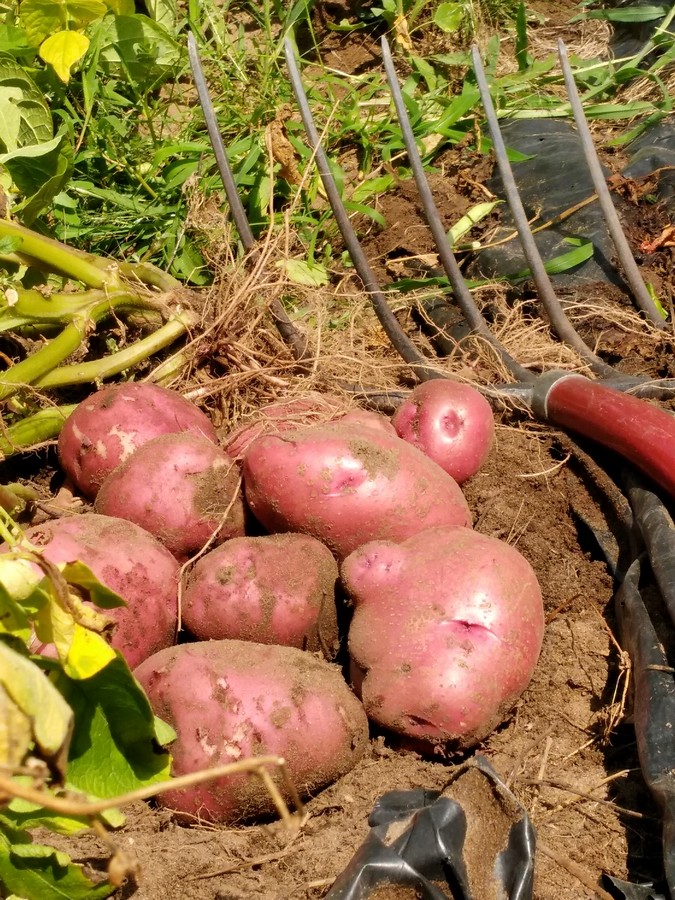
In this post I will go over some details on when and how to harvest potatoes, as well as what I have learned about storage. Also see my other posts in this same series: Part 1, Getting Started; Part 2, Choosing Seed Potatoes, Preparation; and Part 3, Planting and Growing Potatoes.
After a couple of months of preparing, planting, watering, and tending to my plants, all along wondering what’s happening under ground, I find myself getting giddy in the anticipation for a well deserved, tasty reward. The work load has definitely been tolerable, so much so that each year I have found myself wishing to expand my designated garden area to allow for more potato rows. It really is quite simple; when all is said and done, it seemed I did little more than stick the seed potatoes in the ground, cover with dirt, cover some more, water, and wait. Then comes time to dig and eat! I just love sticking my pitch fork in the dirt to discover what might be hiding underneath! What will happen when I turn the soil over? There could be nothing but balls of packed soil and little rocks. But most of the time, out roll firm spuds of different sizes and colors; sometimes yellow, sometimes red, or just plain gray or brown; it all depends on the variety I planted, of course. My kids yell, “There’s one! Wait, there’s more!” What fun, what a miracle! Food, yummy and healthy, right down there in the dirt! I get a kick out of that every time!
Time frame from planting to harvest; when are they ready?
Depending on the variety planted, you are generally looking at anywhere from 2-4 months from planting to harvest. If you wish, you can harvest baby potatoes as soon as 2-3 weeks after flowering has finished, perfect as a delectable side dish for a delicious dinner. These tiny new potatoes are sweet and tender as the sugar has not yet been converted into starch. Gently sneak your hands into the dirt to search for the larger ones, leaving the small ones to grow for a while longer. Or leave the whole crop to finish growing before you harvest.
When to harvest, and what does “dying back” mean?
The potatoes are done growing when you see the plants starting to “die back.” If you are planning to use them right away, they can be dug at any time when this process starts, or even before if size is not important. If you wish to store them, they should stay in the ground a while longer, as described below under “Hardening off.”
But first, what exactly does “dying back” mean? Well, when the tubers are done growing, the potato plants will start to yellow, then become more and more brown and withered until they completely die back. As scary as it looks when you don’t expect it, it is actually a much anticipated sign I look for to know that the potatoes have finished growing! This process can easily be confused with disease, and the first year I grew potatoes I thought something was terribly wrong, and sought advice on how to heal my plants to no avail. The foliage was dying, and there was nothing I could do to hinder it, nor was there any need to stop the process! I have since learned not to fret about this normal and wonderful stage!
To help you know what to expect during this natural process, I have included a few pictures of what my plants looked like when they started dying back. There are a lot of weeds around in these pictures, but the potato plants in the first picture are the two light green stems in the middle with some brown leaves, sprawling on the ground:
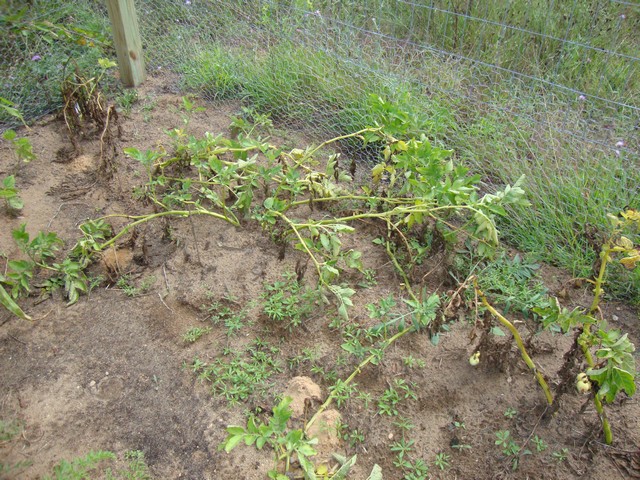
On occasion, potato plants will produce fruits during the later flowering stage. These fruits look like green cherry tomatoes but will eventually turn white. This is the true potato fruit, which contains seeds. The fruit is toxic and not edible! The seeds can potentially be used to grow new potato plants, although this is not normally done as potatoes from these plants will not be true to the original tubers. In the following pictures as the plants continue to die back, you can see these fruits still hanging on the plants, now white in color.

Yikes! Pretty horrific looking for someone who doesn’t expect this to happen! 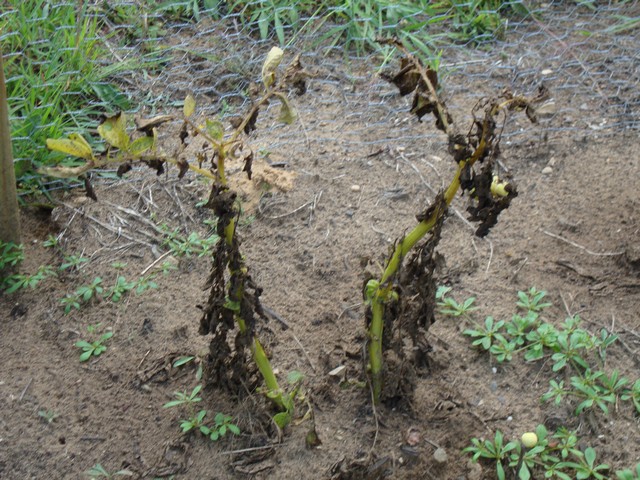
The plants are now dead as can be, an excellent sign!
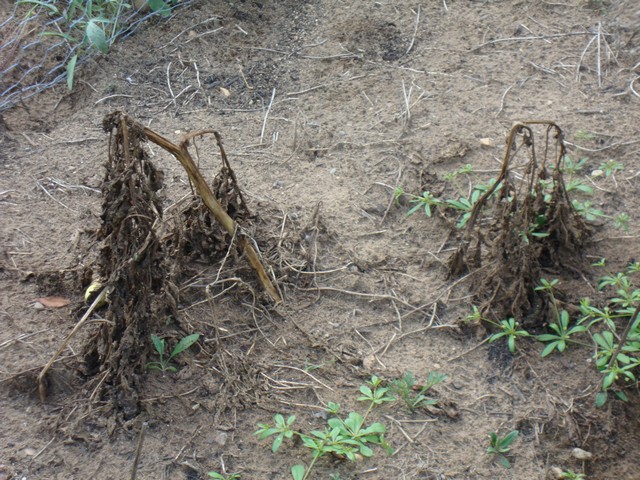
When the potatoes are done growing, I like to leave mine in-ground and harvest as needed rather than dig the entire crop right away. This should not be done if it rains a lot or if the dirt drains poorly because of the risk of rot or sprouting. My potatoes have kept very well in-ground, but I do harvest them within a few weeks of maturing and certainly well before winter sets in since I can expect the ground in my zone to freeze. In milder climates, where the soil is workable all year, some people keep them in-ground all winter.
Hardening off:
If you prefer to store your taters, you should wait 2-4 weeks after the plants have died back to harvest to toughen them up a bit. When you see that the plants have mostly died back, stop watering altogether to prevent rot or re-sprouting your crop. Since the potatoes are now finished growing there is no longer any need for water. Leaving them in-ground for a couple of weeks extra allows the tubers to develop a thicker, stronger skin, which is needed for safe storage to protect them from rot or disease. If you have a very late crop, you can kick-start the process to harden them off before the plants die back by cutting down the stems and foliage and stop watering.
How to harvest:
I prefer to use a pitch fork to harvest my potatoes. After trying a shovel and a cultivating tool first, seemingly slicing and piercing more potatoes than not, I ended up settling on my good ol’ pitch fork. I found that as long as I started a ways away from the plants and worked myself closer, I was able to dig them easily and safely, and piercing some only on occasion. Damaged spuds can still be used, but they won’t store well. I dig a foot or so away from the plant, and being that the pitch fork is a curved tool, I try to dig straight down and not on an angle. Then I push the handle down to lift and turn the soil, moving closer and closer until I have dug up the entire plant, taking care to harvest every last little one to prevent re-sprouting the next spring.
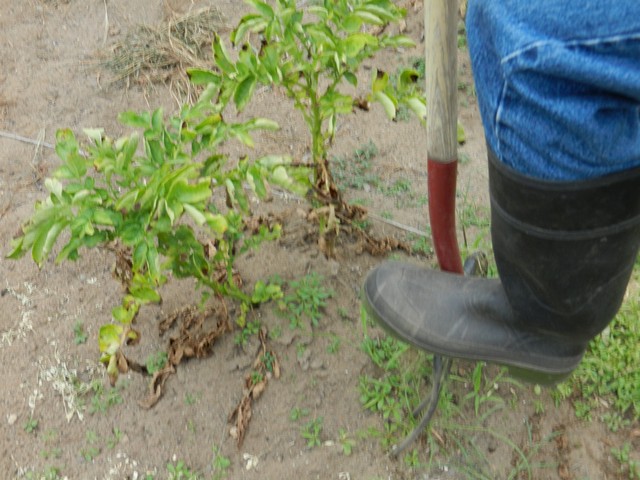

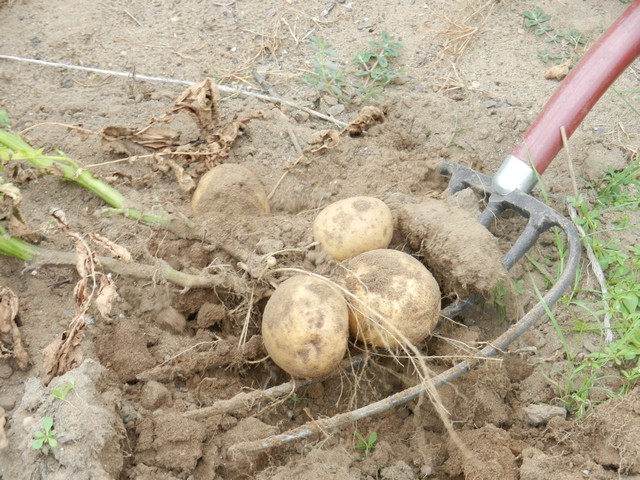
See how the potatoes are connected to the plant in the root area? They are very easy to tear off, and often come loose by themselves when you dig around them.

Sometimes you might be able to pull the plant out of the ground with the potatoes still attached.
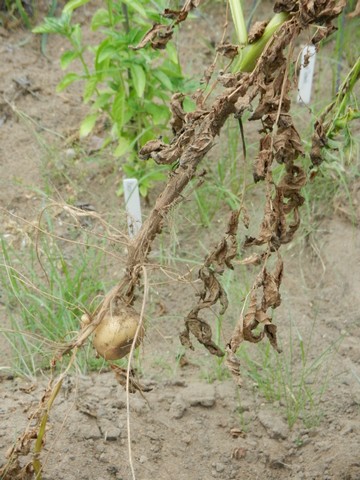
After digging, if you are going to use them within a couple of days, just brush off the worst of the soil and let them dry a bit. If you live in a hot climate, do not leave them in the sun as excessive heat could cause them to cook. I typically dig only what’s needed for dinner, just brush off the excess soil, and bring them right inside to prepare. It is so much fun!
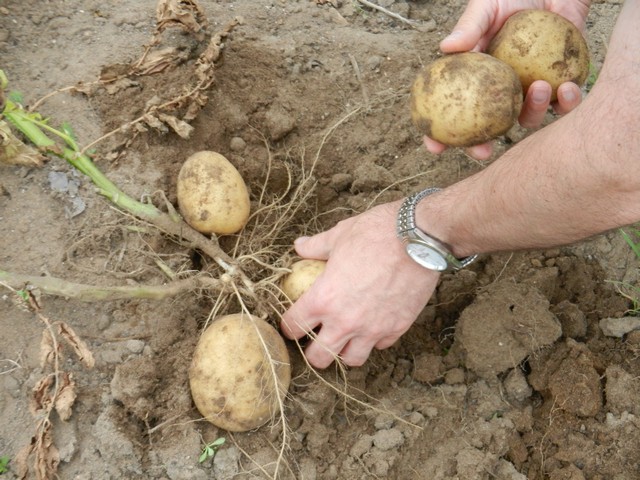
Pick the ones you find, then continue to dig around in the soil and search for more. Pick every last one, even the tiny ones; otherwise they will grow into new plants (and that might not fit with your plans for next season). This plant actually did come from a stray potato that had accidentally been left after harvesting last year, and produced quite nicely. Nice accident!
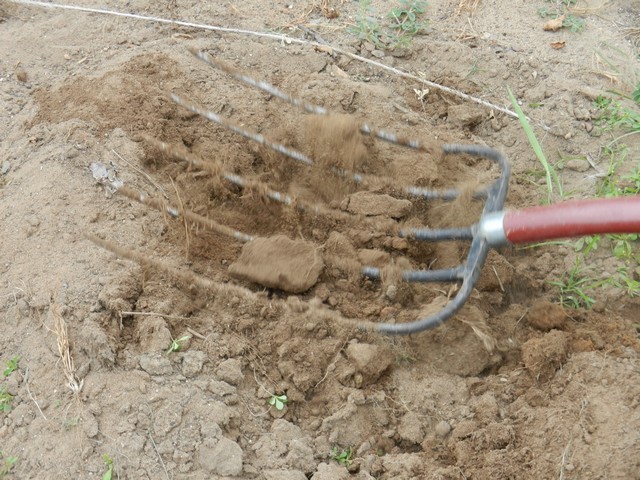
Preparations for Storage:
So far I have always dug and used my potatoes as needed, and long-term storage is not something I have personally tried yet. However, in studying and researching this process, this is what I have found out about it:
If you want to store your potatoes, harden them off in-ground first, as described above. After digging, let them cure for several days to two weeks by letting them dry on newspaper or dry ground in a dark space, such as the garage, basement, etc. This hardens the skin further for better storage. Make sure to keep the spuds away from sunlight, and do not allow rain or any water to reach them. Do NOT wash them if they are to be stored. Excess soil can be gently brushed or rubbed off, but make sure not to damage or rub off any of the skin. Damaged potatoes should not be stored, but used within a few days, although minor cuts and bruises will heal during the curing period.
Here are some of the beautiful red skin potatoes that I harvested.
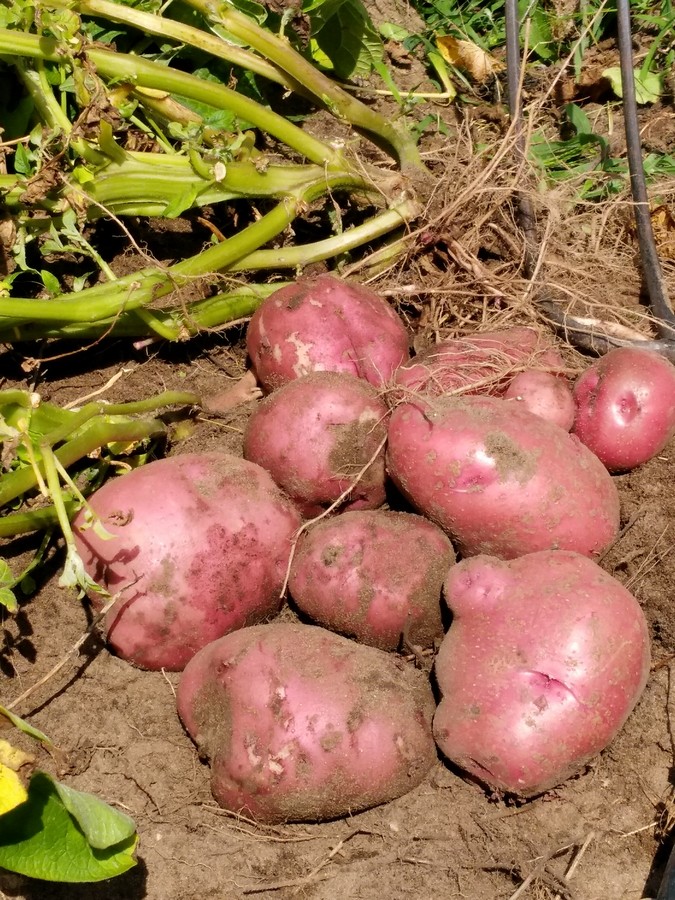
Some were a bit damaged in the process, but I always use those within a few days, so that’s not a problem.
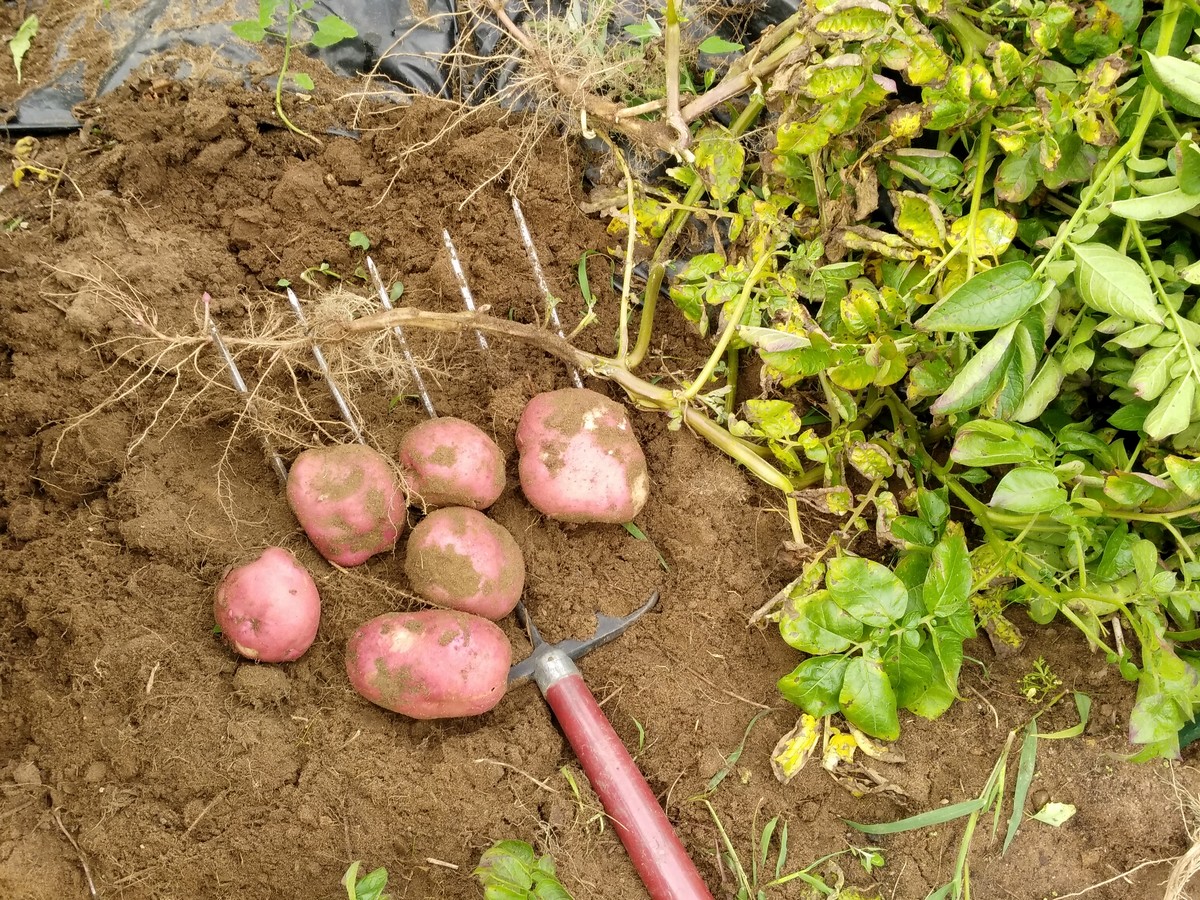
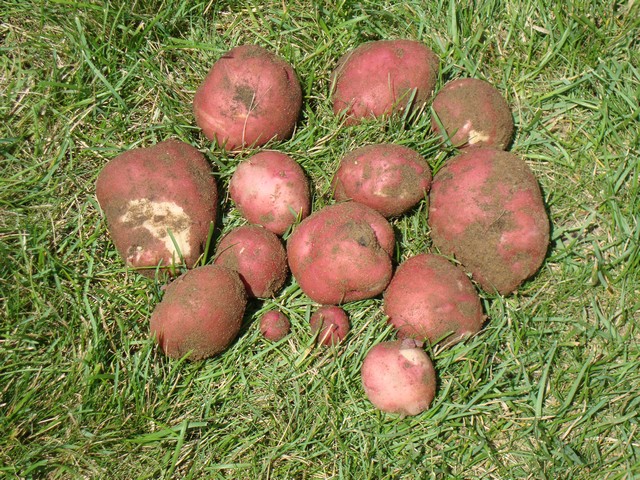
In this picture, the last little bit of my potatoes have been harvested, and my garden is now ready for tilling before winter.
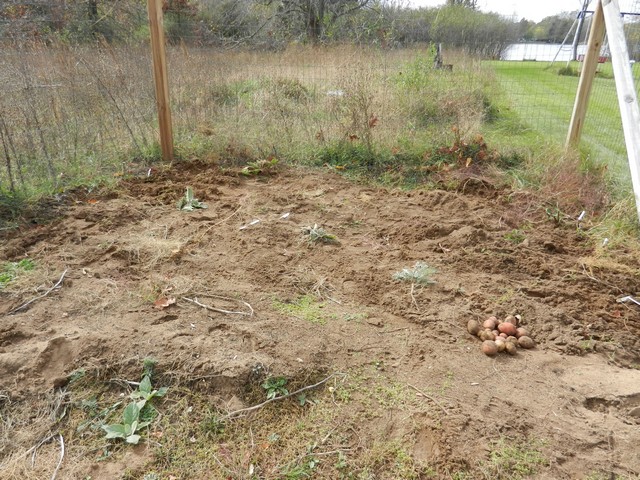
How to store potatoes:
Potatoes should be stored in a cool, but not cold, dry, dark environment, ideally around 45-50 degrees F (7-10 degrees C). Do not refrigerate them as they will turn sweet and change consistency, though this can be reverted by bringing them into warmer temperatures for a day or two. Potatoes do not tolerate frost.
Potatoes can be stored in bins, baskets, cardboard boxes, etc., or even in paper sacks or mesh bags. They do need good ventilation, so the container should be well perforated. Never store in air-tight containers. It is best not to pack them too tight, but keep some air flow around them to prevent rotting. Make sure they are kept in a very dark area, or cover the bins with newspaper or cardboard to keep all light out, to prevent them from turning green. Don’t store potatoes together with onions as each vegetable produces gasses that will cause both of them to spoil. Potatoes in optimum conditions will store for several months, even up to half a year or more.
I remember the potato cellar in my grandmother’s old house; I was never actually inside the cellar itself, but I remember the black, scary hole in the kitchen floor when the hatch was opened, and the tiny ladder the grown-ups would climb to get potatoes when needed. I remember my grandmother warily climbing down into the cellar with a shiver, hurrying back up again and sometimes telling of the giant spiders living there, apparently waiting for their next victim. I’m glad I only had to experience it second-hand! Hopefully all of you have pretty, happy places to store your taters!
If you have any tips or comments, please leave a comment below!
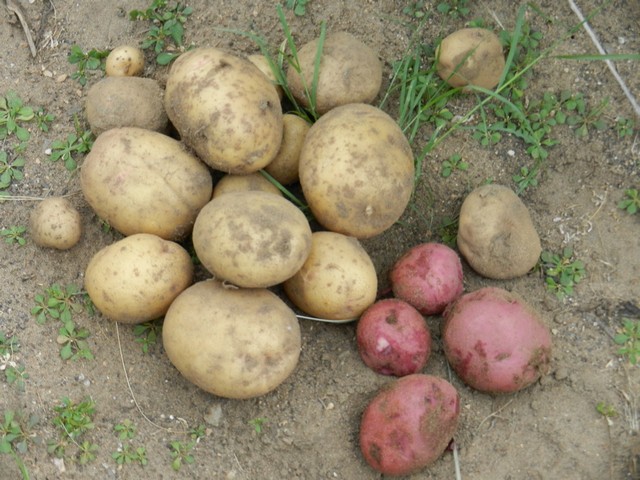



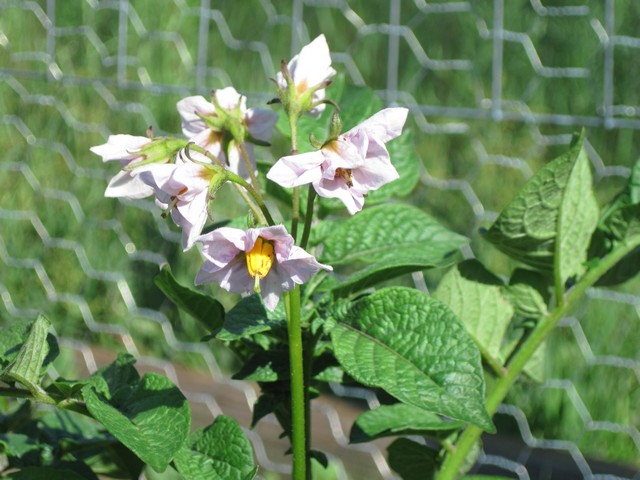

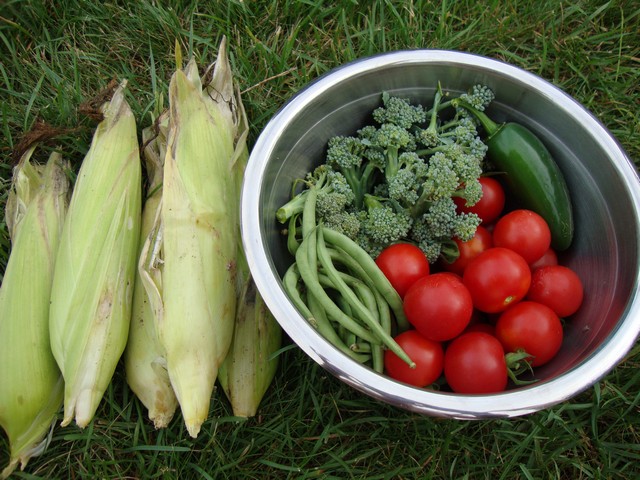
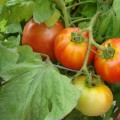
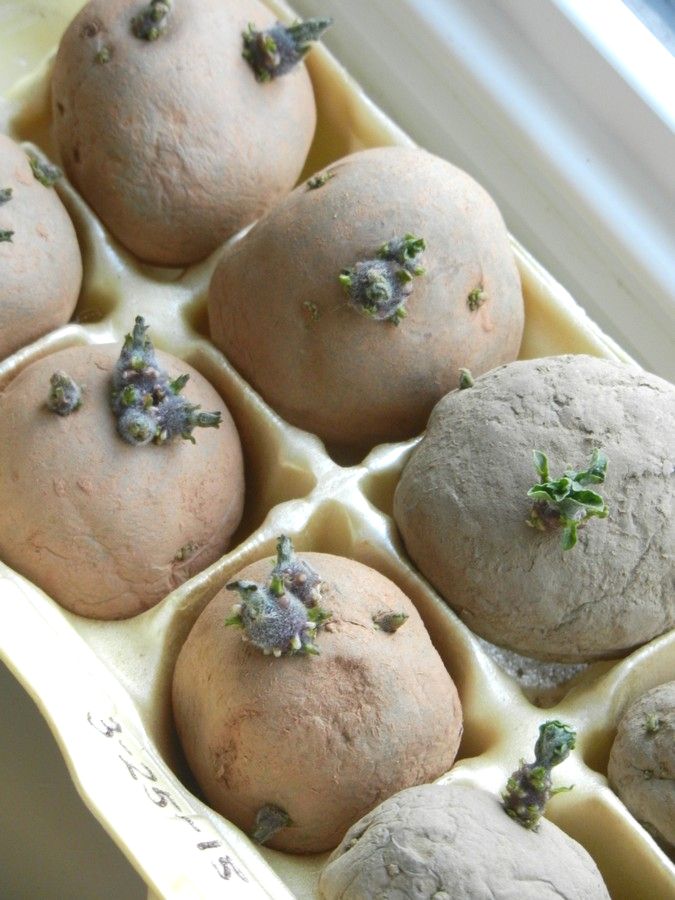
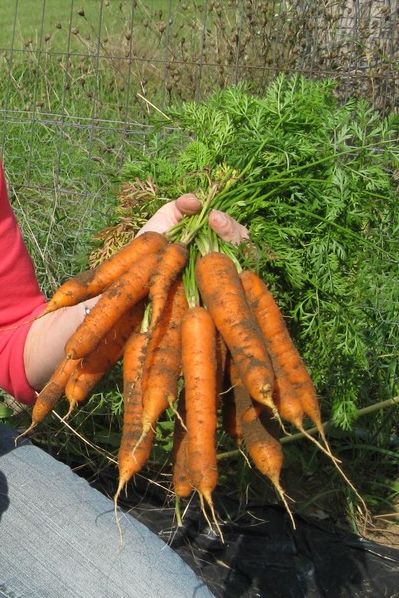
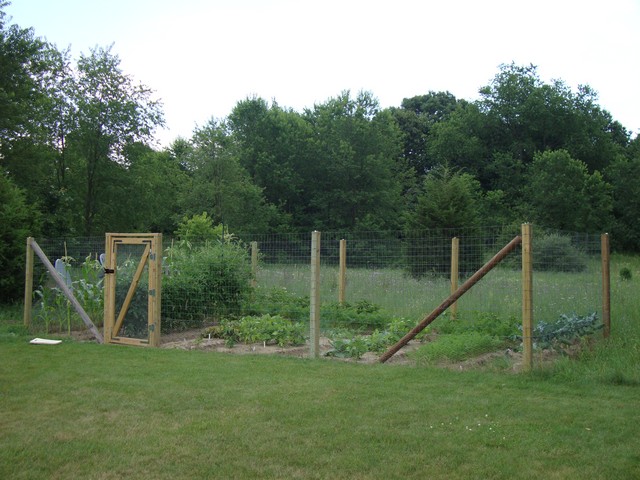
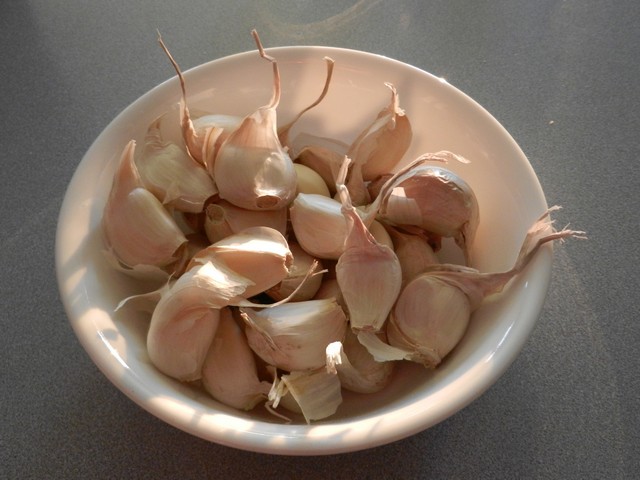

Thank you for this information, 1st year growing spuds and I thought they had all died! I am very relieved and look forward to the digging up process. A very informative site.
I’m glad to hear you found my page helpful! I hope you’ll have fun digging and will find lots of potatoes under your plants!
I’m in the same boat! I was cursing my bad gardening!
Haha! Hopefully in the end you’ll see yourself blessed with a green thumb instead! Wishing you a plentiful harvest!
I wish I could leave my potatoes in the ground as you suggested,however I have problems with voles helping themselves to them.Some years they get more than I do.
Not good! Is there any way that they can be controlled, or are there just too many of them? We do not have that problem, fortunately. It would be frustrating.
Last year I grew fingerlings and yukon golds on one end of my large garden plot. My roommate swore up and down he got all of the little ones out at the end of the season, but this last spring I found myself wading through potato plants in every corner of the garden before I had a chance to plant a single one myself! Since they were growing willy-nilly underneath all of my other plants I haven’t done the big harvest yet and all traces of their foliage are long gone. Any chance you have tips on how to locate potatoes without the plant? I’ll sieve every inch of dirt to get them if I have to, but I’d sure rather do it a simpler way if I can. Also, great article, and I love the pictures.
A few surprises for you this past spring, sounds like! Haha! It seems to happen to me every year. Well, as far as locating them at this point, I’m not sure there is much you can do other than dig here and there where you think they may have been. I would use a pitch fork and dig down every foot or so throughout the areas you think they were located. Once the plants are gone, there isn’t much else to do, I don’t think (other than using harvesting machinery, which most of us don’t own.) And you’ll probably get a few more surprises next year; if so, you could mark the areas with garden sticks of various kinds, just to make it easier to find them after-the-fact. That’s what I did w/ my strays, just stuck down markers and looked for those when I wanted to dig for them. Hope you find some! Let me know!
That’s why I grow my taters in car tyres. I start with a single tyre, putting a layer of soil in the bottom, layering three medium potatoes in a triangle and then covering them with soil. As soon as the potato plant has made about eight inches of growth I add another tyre on top and fill with soil to just below the top leaves and repeat once the potato plant has grown another eight to ten inches with a third tyre. I used straw to fill the third tyre, making sure to pack it in to avoid the greening by light. My potato plants are now about two feet above the third tyre. I could have put another tyre on top and filled that to get more potatoes but I ran out of tyres. Once the potato plants have died back I just remove the tyres and sieve the soil to remove every last tiny spud. Very effective and very easy. I just need to know now whether I can leave the potatoes in the tyres or whether I have to harvest them all at once. I shall be experimenting this year as last year I only did one set of tyres, this year I have six sets of tyres full of potatoes.
Thank you for explaining how you go about growing potatoes in tires, I’m sure others will find this information very useful.
So this tire method is LIFO – last in first out. The potatoes in the bottom should really be used first, right?
I personally don’t know how to go about it, but is seems you’d have to harvest from the top down. Or if all are harvested at the same time, seems they all should have the same freshness level, so I’m not sure that you have to worry about that. I would love to hear input from others on this. Anyone?
Thank you for all the useful info. The pictures were great! Have looked at several websites for harvesting info and yours was the “BEST”. Waiting is the hardest part. I’m like a 5 yr old, I wanna see what’s inside the package! I’ve had a couple spuds reveal themselves to me so I hope there are lots and lots hidden in the dirt. Thanks again for sharing your progress.
Thanks so much! Yes, waiting is hard, but so worth it in the end. I hope you’ll have a great harvest, and lots of fun digging!
I enjoyed reading this. Your writing is very informative and you make it all sound very simple and straight forward. Great illustration too with the pictures. Thank you.
Good to hear! Thanks for commenting!
This is a great site and you have all the information for sure. My wife and I have planted Yukon Golds for the first time at doing spuds. We live at 7000 ft. so have them in large containers due to a multitude of gophers. Very much appreciate your page…am looking forward to harvest time….Thanks !!!
You’re welcome! A lot of people have great success planting in containers. Hope you will, too!
Thanks for your feedback and photos. It’s really helpful. I live in Australia in a fairly temperate climate and I have tried to store my potatoes under the house under hessian so it is dark but they are still going soft and sprouting. i will follow your advice next year!
This spring was my first time planting potatoes, as well as the first time in a new garden and new growing zone for me-8b. I planted them on March 3, and around May 10 the vines started dying back without ever having flowered. I assumed they had a disease or pest problem, but left them in the ground until today (May 28) I went to dig up the plants and discovered potatoes. Any ideas why they never bloomed?
I believe potato plants in warmer climates, such as zone 8, do not necessarily bloom at all. I’m not sure why, but I believe this is a fairly common phenomenon for warmer zones and it does not pose a problem since the blooms are not necessary for potato buds to form. I’m glad to hear you got taters out of it, that’s the important part. It’s always fun to know the why’s around these things, though. 🙂
I am also in zone 8/9 mine did not bloom and I thought they were withered and dead and as I was about to throw in the towel/ throw the dirt out What wud,,,,,,I had potatoes..happy growing
WooHoo!!! You really never know what’s under there, it’s part of what makes it so fun! 😀
I’m in zone 5 (coastal Maine) but the summer has been so hot that my potatoes never bloomed either. And like lots of others, I thought all my plants were dying of heat, lack of water, animal interference, etc. I’m so glad I found your article to clarify and provide much needed info. Thanks!
It can be pretty disheartening, that’s for sure! But of course even if dying back is a natural process, it doesn’t mean it’s impossible for plants to die early due to severe disease, so there’s always that. But if it happens after a lot of growing and everything else seems good, then I would not be worried. 🙂
Hi thanks for the info…very informative! This is the first time I planted potatoes. I did not wait long enough I guess because there were tons of tiny tiny potatoes that would have grown. I did not wait for the plants to die. I read that after the blooms die you harvest 2 weeks after. I did get alot of potatoes!! Very exciting! I did read that you pick off the big ones and then replant the plant to let the others continue to grow. Don’t know about all that but I did and well see!! Thanks again for the tips. I book marked this page for next year!!
Emily
Sounds like you had great success overall, then!! 😀 If you don’t mind, do come back to let me know how it worked out to replant the plants; did you replant the entire plant with the little ones still attached? I’ve never tried it that way before; in fact, I’ve always just dug up the whole plant and used whatever was there and that’s the end of the plant. I have read that you can gently slip your hands down underneath the plant while it’s still growing and harvest the larger ones, and leave the rest to grow, but I have not heard of actually digging up the whole thing. I wonder if the plant can handle that? I am now very curious to know what will happen! Fill me in if you can! Thanks!
This is our first year to grow red potatoes. We have just harvested a first batch, but plants still look great and are continuing to grow. I remember my grandmother letting us dig the new (red) potatoes and she’d cook them that night. Can red potatoes be eaten right after digging? Do they need to be stored any differently from other potatoes. I appreciate your website and the great information you are sharing!
Great memories, I’m sure! I don’t think red potatoes require any different care than other potatoes do; at least not that I’ve ever read or heard about. And yes, you can definitely cook them up and eat them immediately after digging, no problem. It’s when you want to store them that you want to toughen them up. I hope you’ll enjoy your harvest!
Thanks for the informative article and pictures… that’s exactly what my little spud plants have started to look like. I was worried they died in the heat wave!
Thank you for the info. You talked about the tators getting damaged in the harvesting process. Luckily my husband and I wont need to worry about that. We took old tires and double stack them and took some zip ties and secured them together. And we filled them with dirt to use as planters. Last year we had tomatoes in them. But we recently moved and our landlord didn’t have a problem with us planting our garden in the ground. So this season we decided to grow some tators. The plants are slowly starting to dye back. And when they are finished we are gonna take our tarps and put them on the ground by the tires and just kick the the tires over. Can’t wait, because i have a feeling we are gonna have more tators than we know what to do with. 🙂
Sounds like you found a great way to do it! Hope you harvest a ton!
Iv just harvested my first crop of potatoes and couldnt understand why they were so small. Im glad I read your blog so I know exactly what to do from now on. =) if you have any other tips regarding other vegetables I would love to read them
Thank you so much for this information and pictures. I have one plant that has died back, now I am just patiently waiting for the others. This is my first year with potatoes and can’t wait to see how I did!
Thanks again! 🙂
Hi, I have potatoes that grew in my compost. ( old hay,grass,sticks,Food scrapes). Some are very small like some in your pictures and some are green in places, Are they good to eat? Thank you
Hey, small or not, free potatoes from the compost sounds like a great deal to me! 🙂 They should be just fine, although I would cut off the green parts. They turn green when exposed to light, and the green is not good for you. If you cut it off, you should be just fine. If most of the potato is very green, I would throw the whole thing away.
Well, here it is October 6 & my Yukon Golds, (planted from stored potatoes which had lo-o-ong sprouts when first discovered) have never died back, even still have blossoms. We have had a couple of frosty nights, so I decided i’d better get them dug. But they sure have had no chance to harden offThere are several dozen nice sized ones, dozens of golf-ball sized ones, which my neighbor & I are using for stew, & the inevitable damaged ones, which will go for soup, & scalloped potatoes, but what do I do with the bigger ones, which I’ d like to store?
Well, if they are already dug, there isn’t much you can do other than store them for as long as you can in a dark, cool, dry place. Very gently brush off the worst of the soil, then leave the rest so you don’t damage the skins. Follow the above suggestions otherwise, to prepare them for storage. They may not last as long as if they had hardened in the ground, but they should last a little while at least. Just go check on them now and again and find a use for them if they don’t seem to be doing well.
Just so you know, unless October means the ground will freeze in your area, or the soil will be soaking wet all the time from heavy and frequent rains, you can safely leave them in the ground for a while even if there is frost in the air. In my area we have rain from time to time, but not ALL the time, and the ground can still be dug for a while yet even if we have frosty nights. The main goal is to dig them before the ground becomes to hard to dig, or before they rot (or sprout) due to water logged soil. 🙂
Its great to read all the comments, its always good to have new info as this is my first time growing anything. i planted my potatoes from old ones that had sprouted cause i hadn’t used them. They’ve grown really well but the flowers fell off during windy weather few weeks ago, I was hoping you would know how long after flowering they start to die back. My plants are still green and healthy.
Thank you
Good for you for getting started with growing your own food! Learning little by little as you go, the results can be so rewarding! I can’t remember how long it took for my plants to die back after flowering, but it was quite a while. Seems like the flowering itself took a month or more, and then the plants gradually started yellowing and turning brown. I think it can vary by your area and by plant, but flowering is a fairly lengthy process, if the plants flower at all. Some don’t, especially in warmer climates. The plants still need time to develop, of course.
If you start feeling antsy, I’d say go ahead and dig up a plant and see what’s happening underneath; if you want to store them for a longer period of time, then you’ll need to allow the plants to die back fully and toughen up a bit before digging, but if you’re using them right away, then you can probably dig as you need them anytime you want to at this point. If they are still tiny, then wait a while longer.
Thanks for replying so quickly. I’ll just have to stop acting like a 5 year old, try to be patient and remember that they still growing while they’re leafy and i could have lovely big potatoes. 😉
You’re very welcome! 🙂 Oh, I don’t think you’re acting like a baby at all, it’s just very exciting and fun to see what might be hiding beneath the soil! 😀 I like to dig them little by little as we need them rather than storing them, anyway.
Nice site. I love growing potatoes, harvesting, and of course cooking them up. Such a miracle food when considering how easy they are to grow and how great they are for your health with the skins on. Also such variety that you`ll never get bored growing them.
Yeah it is a good job u did.
Sorry let me ask you
If you dont have a room but you have a piece of land only can’t we dig a big HOLE so that we can store there? on the conditions you stated
That’s an interesting idea, for sure! Same concept as a potato cellar, I guess. I don’t know if it would work the same way, but seems like it would be OK as long as the potatoes are kept away from frost and water drainage. I know many people will leave potatoes in the ground where they grow, digging as needed, until the ground starts to freeze. So my guess is that it would be OK. You’ll have to use your own judgement or research a bit.
Have waited many, many years to grow my own potatoes. I do not even know what they are namled. However I am enjoying the plants, did so get a lot out of your site, great help. Looks like I need to add a pitch fork to my garden tools. I like to shop for tools anyway, ha. Thank you so much for taking the time to help us along. Will keep this site in my bookmarks.
How long can you leave them in the ground
Until the ground freezes, or until you’re in a time period of a lot of rain; you don’t want them to rot or sprout.
I wish I had found this site before I planted……I think I may not have planted my seed potato deep enough. I think I got most of them about 3 inches deep and they are probably to close together. Should I wait until the plant starts to grow and maybe remove some? Thanks!
There’s no need for concern on planting to shallow; just shove more soil on top! 🙂 If they are too close together, they may not produce as well, so removing some might be an option if you really think they’re too close together. I’m not sure when the best time to do this would be, but probably pretty early on, I would think.
Wow…so very informative. This is our first year growing potatoes, and I found this site to be invaluable, in terms of how, when and where (how far to dig) to harvest the potatoes. Our potatoes were planted in early April (we’re in zone 6b) and the plants have recently begun to flower. I think I’m as excited as our kids to have some home grown potatoes to cook and eat! We are looking forward to digging up some potatoes when they begin to die back. Many thanks for your expertise and for the wealth of information you have provided!
I’m glad I could help! Thanks for commenting, it always inspires me to see that people find my posts helpful. 🙂
This is my first year growing potatoes. I chose red. Funny story, I asked the man @ the city seed store where are ya’lls potatoe seeds (I expected little seeds like tomato,cukes ect) when I saw they were just potatoes with what my Mamaw called “eyes” I felt like a fool! But the man was nice and told me how to plant them, along with alittle research they were growing and flowering. I never got any fruit that I no of ans seems like something got the flowers(maybe a hornworm) I will be showing this to my dad to. He tried telling me it was time to dig them up (I think he was just being eager to see) well I dug up 2 plants and they were the size of a cotton ball! He told me they just weren’t going to grow, but I told him I was gonna keep the faith! They just needed more time the plant needed to be dead. I sent him a pic today of 3 I dug up that were just yellow stems with brown leafs they were the size of tennis balls and some smaller. Good tip on leaving the smaller ones attached. I can’t wait to see the rest when they are done!
Haha! Too funny! And good for you for sticking it out to get potatoes larger than bite-size. 😉 And if something got the flowers, that’s why you didn’t get any fruit. The fruit is a result of the flowering. But that’s not big deal anyway, since it’s the taters you want, not the fruits. But the flowers are pretty, so that part is always nice.
Like many others who have posted this is my first year growing my own potatoes. My grandfather had a huge garden growing everything but he passed on a few years ago and his extensive knowledge went with him. i planted my seed potatoes very shallow and they have at least foot tall plants right now. I planted just before the fourth of July so I figure that I have a ways to go to maturity. does that sound right? If I want the small potatoes that my grandfather called “new” potatoes would they perhaps be ready by now to dig a few? I may try one plant just to see. I’ve counted over thirty plants so far in yukon gold and red that I bought. Also, a note I bought seed potatoes that have very, very long roots (off the clearance rack) at our store which I think are a great solution or is this wrong?
I would wait a bit longer before digging. Not sure if your plants are flowering yet? I would leave them until the flowers start to die back. You can take them at any time, but the earlier, the smaller they will be. If you dig too early, you won’t really get anything at all, so there’s not much point in that. They say anywhere from 50-75 days for early potatoes (new potatoes,) depending on variety. Also, while they’re growing, start hilling dirt up along the stem, covering leaves and all. The tubers will grow along the stem, and will be damaged from the sun if not covered with enough dirt.
I found reading through everyone’s comments and your replies very interesting. I’ve been trying to grow some spuds but unfortunately the ones I grew (I can’t recall the variety) didn’t and aren’t flowering. The plants look very healthy though so I’ve left them as I note you said some varieties don’t always flower in the warm weather and here in the wilds of Shropshire, U.K. just lately we’ve had some very unusually hot weather. I look forward to visiting your site again and reading comments from everybody. Like someone else commented, it definitely is the best site I’ve found being informative and tells you exactly what you wanted to read. Many thanks again. Sue M
They might still flower, maybe they just aren’t that far along yet. Regardless, check later on to see if spuds did in fact still grow. 🙂
We’ve grown our own potatoes for years. Sometimes there are no blossoms at all. That does not seem to affect the potato development.
What a great site! The photos help a lot.
I have been growing potatoes for many years, in zone 4. I’ve narrowed down my varieties to Yukon gold (a great keeper) and Norland, a heavy producing red potato. I use the nicest potatoes from the previous harvest to plant, and I have a three year rotation in my garden. (there’s always a few potato plants among my onions!).
At the beginning of the harvest, when I only need a few potatoes, and the plant is still green, I harvest the largest potatoes and replant the plant with a bunch of tiny potatoes still clinging to the plant. I then water the plant and they do keep growing, getting to be about half the size of a full grown potato.
For the past few years none of my potato plants have flowered. It’s a mystery. And I’ve also had fewer and fewer potato beetles. ZERO potato beetles for the past two years! (touch wood!)
Happy gardening!
That’s interesting that you can replant the plant along with the small potatoes, I didn’t know you could do that! Why why not, as long as the roots are intact.
Hi Teresa, The posts on your site make very interesting reading. In my past work ethic I had contact with the farming industry and was always told not to plant potatoes in the same ground year on year. What are your thoughts on this question? This is my second year growing in the same spot and I have harvested a couple of plants. The first few taters were softish and tended to go into the water when cooked, was this due to not “hardening off” ?
Also this time round I did a much better job on preparing the ground by digging deeper and removing stones and also digging in compost and chicken manure. Would you agree this helps ? , what are your golden rules re feeding the ground?. Everything is dying off now above ground so I plan to leave them in ground for as long as possible.
Regards, Ron
If you will permit me to respond — definitely rotate your crops! We have number of raised beds– very raised (about three high), and beans always follow potatoes, as they will replace nitrogen in the ground. I generally will follow beans with either peppers or tomatoes. Root crops of any kind (carrots, beets, potatoes, etc.) never go in the same ground until at least three years have passed. This not only keeps the soil from being depleted, but keeps the pest problem to a minimum.
The second year potatoes were probably suffering from a fungus which affected the plant — another reason to rotate crops. A fungus which attacks potatoes won’t touch beans, etc.
And yes, adding composted supplements to the soil is a must. We do rescue work with animals so I have plenty of manure to compost and most of my veggies grow in almost pure aged compost.
Do not leave potatoes in the ground once the rains start. Although you cannot freeze plain potatoes, you can prepare tons of mashed potatoes, cool them a bit, shove them in zippered baggies and freeze them to enjoy during the winter. They will look really funny as they defrost, but once fully defrosted and heated and stirred well, you cannot tell them from freshly mashed.
Helen, that it an amazing idea. I love mashed potatoes and to have them ready made just to defreeze etc., would be wonderful. Thank you for that information.
I also loved Teresa’s article and pictures regarding the small tomato looking things growing up the stem. I learned that they were not edible, which I might have tried. So thank you also, Teresa
You’re welcome!
Ron, I apologize for not giving you an answer on these things, I somehow missed it. But thanks to Helen who stepped in to help! I do agree with her. Rotating is very important, and not hardening off will not cause them to be soft when freshly harvested So there was probably something else wrong with them like Helen suggested. Fertilizing in the beginning of the season is definitely recommended, although don’t overdo it for tomatoes and carrots. Feeding with organic matter such as manure or compost is great! To my understanding, you should go careful on manure for potatoes since it is high in nitrogen, which you want to go a bit lower on.
good info ..thanx teresa…. anytime i have grown tatties ,i dig them up give them to the wife to cook but they always turned to mush,till someone told me to let them dry- off as he called it before cooking them but for how long ?
Hmmm… turning to mush while cooking sounds like over-cooking to me. It often helps to put them in cold water in the pot, then let them warm up as the water heats up on the stove. This will prevent the outer parts to finish cooking before the insides are done. Mushy potatoes is also more common with the russet types, the more starchy potatoes.
What a nice, detailed tutorial on growing potatoes. Thank you.
This year I preceded my ‘raised bed ‘tater garden’ with a cover crop of inoculated clover, planted in the very early spring (zone 9b) – turned in 3 weeks before planting – started with 10 inch trench and continuously buried the stems to up to about 8 inches as they grew above ground. The potatoes grew en-mass near the bottom of the trench, and the heaped earth made it perfect for harvesting – a stellar, healthy crop.
Hi. Terrific selection of photos and explanation.
We have the “cheery” seeds on our potato plant.
Have you ever grown from them?
Peter and Kathy
Weston ACT
Australia
Thank you! And I am not familiar with cheery seeds; what is that?
Hi, Great reading your tips. I planted lots of potatoes last year and had a massive harvest but never got round to digging all of them up, Will these regrow into healthy plants. Or should I dig them all up now and start again fresh
Sounds like you had a great season! If you leave them in ground, they will grow into new plants, yes. But whether they will be healthy or not, is hard to say. It is not actually recommended that you allow them to resprout like that as there can be a lot of diseases lurking, even if the potatoes seem healthy. You are not even supposed to use a potato from your own garden at all for a new crop, for the same reason, but use certified seed potatoes. Well, I often have little “strays” that grow unintentionally, and so far mine have been healthy, but it is a chance to take. In addition, if you don’t dig at all, they will be way too close together and won’t have enough space. (Several eyes per potato, and lots of potatoes close to each other, with the potential of a large amount of plants in one spot, competing. I think that your best bet is to dig them, and you could still miss a little one here and there, so there might be a surprise plant or two regardless.
Another note: if you allow the potatoes to regrow, and they will, THIN THEM! Or you will have a horrid crop of tiny nothings or a lot of rotted potatoes.
Yes! 🙂
So much great information here and I really appreciate the images. We were new to growing potatoes last year and failed to even harvest them at all.
This time around I have high hopes for success and a nice little crop to expand on next season.
Thank you for a great tutorial!
That’s nice to hear, thank you for commenting to let me know! I hope you’ll have lots of taters to dig this time around!
Hi,
Thanks for the great information and also pictures of different stages of your potato plants!
I am growing potatoes in potato bags right now. I planted them on February 15th. I had beautiful green for fiage and now some of the leaves are turning yellow and brown and very mushy to the touch. Is this normal at this stage or is this late potato blight. Looking at your pictures I can’t tell if it’s a hard dead stem with hard (crispy)brown leaves or is it mushy. Please help!
That’s really hard to know; I don’t think mushy is necessarily a problem. I think that dead plant material will be dry and crisp or mushy depending on whether it’s been in contact with water, and even if it’s been kept dry, there is still moisture in the stems if they aren’t fully dead and dried out yet. You can try to sneak your hand down under the plant and pull out one potato if you can, leaving the rest until you want to harvest all of it. Inspect that one potato and see if it appears healthy. Late blight happens on occasion, but it’s something that wipes through the entire geographic area and there isn’t much you can do to prevent it, and nothing at all to treat it. It is what it is at this point, but I’m thinking your plants are fine if you only go by the mushiness of the stems. I personally wouldn’t be too worried about that. 🙂
No fear, Tina Grant! I just grew 2 grow bags of potatoes, one red and one russet. They grew very nicely and then started to die back. It’s easy to think you did something wrong. That’s when you stop watering them and just let them do their thing. I don’t think you over watered them because the grow bags drain very nicely. I emptied both of my bags out yesterday and had a few dozen potatoes, some bigger than others. I’m keeping the teeny tiny ones in a brown paper bag with a few holes punched in so they will sprout and I can replant those. I live in Florida and I can grow year round.
I prefer container growing over the bags actually, because I used those poly grocery bags and they disintegrate rather quickly. I suppose if you bought the official “grow bags” they might hold up better. I saw lots of information online about growing in 50 cent walmart reusable shopping bags, and I tried it, but I prefer the container.
When growing in containers, just make sure it’s at least 20 to 25 inches deep. Plant the eyes about 6-8 inches apart. When leaves emerge, bury them again up to the tippy top of the leaves. Keep the soil moist, but not too wet. Let them grow a few more inches and bury the leaves again, and again, until you reach a few inches from the top. Then let them grow and flower. Like many have said, sometimes they don’t flower at all. But if you keep them moist and they have sun, they will be producing potatoes under there. After the leaves start to turn yellow, I hold back on the watering and let the plant die off. It sounds like you are in the dying off stage, so give it a few more weeks to turn dry and brown, and dig for your goodies 🙂
Thank you Jackie! 🙂
Have you ever tried planting them in old tires? Put the first tire down with soil and plant 3 to 4 seed potatoes… Depending on size of the tire. As the plant grows add another tire and cover the plant with more dirt. When you get to 3 tires tall let the plant grow. When you are ready to harvest just tip the tires over and you will find potatoes from the bottom up. You will find you yeild more this way. However may take a little longer to harvest.
Thank you! Yes, I’ve seen blog posts on that, pretty neat that potatoes are so versatile like that!
I just found out that my red potatoes have Michigan disease. After researching I thought it best to go ahead and harvest. So I dug up a couple plants today and some of them have the little white spots all around them. They wipe off very easy. My question is this. Are they still good ? and I watered this morning so they are wet how should I dry them ? Thank you in advance
I found this site very useful for me as this is my first garden.
I’m sorry, I don’t know anything about this disease, so I don’t know if they’re still good. I’m guessing they’re OK if the spots wipe off, but I couldn’t tell you for sure. If you want to store the potatoes and they’re wet, you can wipe them gently with an old towel or paper towel, then let them dry fully in a single layer outside but away from the elements, also with no sun exposure. Turn them over when you see that the top side is dry. I hope your taters will be good to eat still! You could contact a garden center and ask them, also regarding how to prevent this disease from attacking a future crop. But do plant your next crop in a different spot since the disease could still be in the soil. All the best to you!!
Why do I get potatoes the size of my husbands shoe. They taste great but are do big!
Wow! Must be you’re doing something right! That’s a good thing! If you don’t want them that big, you could harvest a little bit earlier, they’ll have a nice, soft, thin skin on them and so tender! But I would be thrilled with huge potatoes! 😀 Nice job!
can you plant potatoes like in your yard and after they flower mow the top offor do they need the top of the plant to continue growing underground?
No, sorry, you need to let them grow. 😉 The thing is, they will grow potatoes from along the stem as the plant grows up. So if you cut it off, there won’t be anything to grow from. You also need to dig more dirt up along the stem as it grows, so you’ll end up with piles of dirt around them after a while.
Hello:) so glad I found this sight… So informative! Thank you! I do have a couple questions: I live in Kansas and has been pretty rainy. My potatoes have been in the ground since March 11th. I planted the seed potatoes and then covered the ground around them with straw hoping to help with weeds.
They were doing beautiful… But when I go out there now, the leaves have brown spots on them…from the pictures I have pulled up on the web, it does not look like blight, but I don’t know what else it could be. Any suggestions on that? And if so, how to treat? Also the leaves near the ground are yellowing…
Also, after I have dug up the potatoes, do I need to let the ground rest before I plant anything else?
Any answers/help would be appreciated… Thank you!
I’m not sure what the spots and the yellowing might be, unless they’re simply dying off. The plants (not the potatoes) will die eventually, that’s normal, and in that process they will look really bad! There are also a ton of different diseases that can attack potato plants, but since I’m not a professional, only a hobby gardener, I simply don’t know. Not all diseases will affect the potatoes, though. Could you try to harvest them now? If you look up growing time for the variety you planted, that should give you an idea whether they’re finished growing. Most varieties take around 3 months, but it could be anywhere from 70-120 days. Another thing you can do is to take a picture, describe what’s going on, and post it on houzz. Gardenweb merged with houzz, and there’s a great gardening section there with lots of very knowledgeable people who will help you. http://forums2.gardenweb.com/forums/cornucop
Lastly, I believe you can plant other crops again right away, but fertilize first, and avoid plants from the same family (tomatoes, peppers, eggplants) to cut back on potential diseases.
Most mid-west universities have agricultural extensions where you can check regarding various diseases and what to do about them. Pest identification is another area where they are especially helpful. If you live in a rural community, you probably have a feed store available to you and they will know who can help if they can’t.
Thanks for the excellent coverage on potatoes. My first potato harvest is done. The plants have wilted. I was wondering how long I could leave the tubers in the ground. It’s Texas with summer about to hits us in all its glory. For the next 4 months we won’t go below 92F. The tubers are in plastic containers, which I’m eating first, and in a wooden raised bed.
Thank you.
Well, I’m not entirely sure, but from what I’ve gathered, they should be harvested before really hot weather sets in. So you probably need to dig them and try to find a cool area for storage. I’m glad you otherwise found the information helpful! Thanks for commenting!
Love reading your article and it was so informative. This is our second year of planting potatoes and I was worried there was no blooms on the plant but after reading your article and looking at the photo I’m now waiting patiently to harvest our potatoes.. Thank you again for your informative blog
You’re welcome! And happy harvesting! 🙂
Terese, thanks for the valuable info…this is my first year…the package said harvest midseason…so I did! From just 12 small seed potatoes, I was thrilled to harvest about two gallons just today. Of course, seeming a bit psychic, as I was washing the dirt off…I remember thinking “I am likely violating some esoteric rule and should NOT be WASHING these at this time!” Don’t know why I didn’t search for your site before then, except, there are times when I am impulsive! I remember the storage under my aunt’s kitchen sink, and I remember when I was tasked with getting some tubers out, back in my youth (when dinosaurs roamed the earth…) I remember that they still had a little soil still on! Why do humans act against their instincts, I wonder? All philosophy aside, I am fully prepared to make a big potato salad, but will try storing them for a while…they will not last long, at any rate! Now that I know you’re here, I will take the make-up lessons of parts 1-3! Thanks, again, for your wisdom! Now I know! Since I live in north Texas, is it delusional to think I can get a second harvest this year from the little ones I left?
I am sorry I missed your comment until now! I apologize for the late respond!
Regarding your comment, oh, I know what you mean, I can be impulsive too and I just want to do what I’m doing, hoping it’s the right thing rather than making sure it IS the right thing! Haha! And I love your sense of humor!
As far as whether you can get another harvest in, in your area, I would certainly think so; you could at least try and see what happens. They do like cool weather, of course so you could maybe plant one to experiment, and save the other ones for a while so you’ll have a fall harvest. I’m not sure how well they’ll grow in the heat of the summer in Texas, but if you don’t try, you won’t know. 😉 I’m in the midwest, so it’s not quite as hot here. Just one point to remember: it is not normally recommended to seed your own potatoes as they can carry disease, even if they look fine. You’re supposed to use certified seed potatoes from the store… Having said that, I have missed small ones that decided to seed themselves the following season, and they’ve been fine.
OK, good to know for those of you in really hot climates: My husband watched a show on potatoes, I think it was regarding how to make potato chips, and they mentioned the fact that when it’s really hot out, potatoes can sometimes cook right in ground! So they were trying to harvest before the potatoes got cooked, in order to not lose their harvest… Wow! “Dinnertime, everyone! Here’s a pitchfork, go get yourself a baked potato! And grab some chives while you’re out there!”
We live in Kansas and yes it does get hot. This year several weeks sporadically in the very high 90’s and several 100’s. I use a 16″ single bottom plow to get mine in, then a homemade hilling attachment to get them a extra few inches of soil on top after they have came up. For me this seems to alleviate the “cooking” in the ground problem. This year with the extra rainfall we have had the best crop ever. I have 12 rows, 50ft long and seem to be averaging about 80 lbs of extra large taters per row.
Speaking of row, I stake the ends of the rows and sometimes in the center of the row, depending on how crooked I drive, then run string down the rows to make sure I know where the rows are. I will adjust the string and the stakes as the plants come up so I know where they are. I usually don’t finish digging till late September and by that time the stalks are long gone. Thanks for the good information I got from reading your posts.
Great tips you shared, there! Thank you very much!
Can the tiny New potatoes or red potatoes that are still clinging to the roots when I harvest the more mature potatoes be replanted? If yes, Do I just pull them off and put them back in the ground? Also, do I leave some of the rootage that they are attached to on the potatoes?
Thanks for your help, Debbie Smith
Very good questions!! Well, the answer to your first question is “yes” and “no”……. Yes, they can be pulled off and replanted and will grow their own, new roots and shoots from the little “eyes” / indentations in the skin. BUT: You are really not supposed to do that as your own potatoes can carry disease from the current growing season, even if they look healthy. Potatoes are notorious disease plants, so you should use certified seed potatoes, which are quite inexpensive. Even so, I often miss a tiny potato here and there during harvest, and those will grow into new plants the following season all on their own. I have harvested very nice potatoes from those “volunteers” potato plants, but it still is not recommended to plant them on purpose since they will be more susceptible to disease, which can be discouraging. It seems better to stick to certified seed potatoes. 🙂 Hope that helps!
first time growing potatoes so not sure what I’m doing however after just planting three potatoes in ground that had eyes I’ve had a great crop. Question is do I pull up the plants or if I leave them will I get another crop ??? Thanks
Well, you only get one crop per plant, but if you harvested while it’s still working on that first crop, there may still be new ones coming. Especially if the plant is strong and vibrant. You just have to be very careful when harvesting so you don’t destroy the root system or the original seed potato, or the plant itself. The tubers themselves are not roots, so you definitely can gently remove them. If you do see / feel tiny ones still there, and the plant and roots are intact, you certainly could try to leave it alone and see if it makes it. If so, the tiny ones should continue to grow. 🙂 Hope that helps!
Hi, I store my potatoes in a large enclosed vented bin in my husband’s shop. They are stored with peat moss. Living in MT they stay very cool in there. This spring was warm and my potatoes started growing in the bin and produced small potatoes that are edible size, but I’m not sure if there OK to eat being the mother plant never had sunshine? Does anyone know the answer? I have a 5 gal. bucket full . Any help well be appreciated. Thanks
Interesting! I’ve never heard of that before, but I’m guessing they’re still edible? Maybe not as nutritious??? Anyone know the answer to this? Otherwise the gardenweb on houzz might be able to help.
Yes, they are edible. The only time to NOT eat a potato which is firm is when it has been exposed to sunlight long enough to turn green. If you cut all the green area out, the rest of the potato will still be good. Snopes has the best lay explanation I am aware of about green potatoes:
“The potato, the ultimate comfort food in Western society, has a disturbing secret. This trustworthy old friend so often invited to our tables can, at times, slip us a little bit of poison.
The potato — or, rather, green versions of it — contains a natural toxin called solanine. The greenish hue that should warn you away from such spuds is actually chlorophyll, but its presence indicates concentrations of solanine are present in the tuber.
A glycoalkaloid poison found in species of the nightshade, solanine is a nerve toxin produced in the green part of the potato (the leaves, the stem, and any green spots on the skin). This bitter poisonous crystalline alkaloid is part of the plant’s defenses against insects, disease, and predators. Potato leaves and stems are naturally high in glycoalkaloids, so ingestion of these parts of the plant must be avoided at all costs.
Solanine develops in potatoes when spuds are subjected to light or either very cold or warm temperatures. It interferes with the body’s ability to use a particular chemical that facilitates the transmission of impulses between cells. Ingested in large enough amounts, it can cause vomiting, diarrhea, headaches, and even paralysis of the central nervous system.
However, unless you are deliberately seeking out green potatoes to eat, you are unlikely to ingest enough of the toxin to do harm.”
Read more at http://www.snopes.com/food/ingredient/greenpotatoes.asp#MOzx12Cc39qc3Rjy.99
Thank you, Helen!
Where was this blog before I panicked and pulled up some of my dead looking plants. I thought I did something very wrong. Your blog post was extremely helpful and taught me some things. I have one concern. My potatoes where planted for 3 months and look like it the potatoes where just coming in. I got baby potatoes, like fingerlings, but no large ones. The top of the plant started turning yellow and withering. What did I miss? Did I pull them up too soon?
Haha, sounds like something I would do! But at least if the plants looked dead, you didn’t do much harm in pulling them. 😉
As far as the small potatoes, it can be really hard to know. One issue could be excessive heat, or not enough water, or even a nutrition problem. If the plants are still quite green, you may want to let them be for a while longer before pulling them as they may still be growing. I highly recommend going on the garden web area on the web page “houzz” (the two of them merged), where you can share more information on the specifics of your garden so that they can help identify the problem, and they will ask more questions to be able to close in on the issue. There are a lot of variables.
Thanks for the excellent article and great pictures. I planted my All Blues on May third, and they are dying back nicely. I was indeed worried, since this is my first year growing potatoes. Fortunately, though tough winter up in Maine killed a lot of the potato beetles, so we caught a break there.
Instead of hilling up the individual plants, I just mulched heavy with straw. We’ll see how it goes.
I wanted to ask you one question: I have been walking quite a bit, in-between my 36″ rows, to scout for bugs (and slugs). Should I be concerned about the soil compacting?
I really appreciate the good advice and will probably stop watering them now and harvest them all on Oct 1.
(Other gardener friends were asking what the green spheres on the potato plant were. Apparently, even some
potato growers had never seen them).
You are getting great experience and knowledge already! Good for you! I would not worry about compacting the soil in between the rows, and you would naturally not be stepping directly on the hills where the plants are growing and tubers forming anyway. The only concern about compacting the soil between hills / rows would be if you were not finished hilling, since it would make the job much harder. Sounds like your plants are past that stage anyway, so you should be good. Thanks for your comment! 🙂
I also chose to use a heavy layer of straw around my growing plants this year and it worked beautifully. I had hilled in years past but took the lazy way out this year and had no problems at all — a little straw grass, but that pulls up easily and also keeps other weeds out.
I have read about mulching with straw previously, but have never tried it. Maybe it’s time that I do. 😉 Sounds easy, and it can be tilled under to compost at the end of the season.
In the early 1900’s, my mother-In-law grew up on a potato farm in North Dakota. Her father would store root vegetables in wooden barrels buried in the ground. Throughout the winter, they would uncap one barrel at a time and eat its contents before uncapping another.
That’s Interesting! I’m sure it worked very well. Previous generations knew so much about how to live independently and grow their own food, and I think a lot of that has been lost for today’s younger generation. There is such value in listening and learning from our elders! Thank you for sharing!
wow, thanks for writing this. I really enjoyed the photos and you answered a lot of questions for me.
Thank you for your comment, I’m happy to know you found my post helpful!
Awesome article! My plants got pretty chewed up by bugs – possibly grasshoppers. They look pretty sad & are starting to die. I harvested some yesterday with great results, but I thought I was going to have to dig them all up because another article I read said they would rot if you left them in after the plants died. Glad to know how to harden them off before harvesting and not to worry about what the plants look like.
Any suggestions for the bug problem for next year? I would like to keep my garden organic.
Bless you!
Good to know your potatoes were good, even if the plants looked sad! 🙂 I have used Captain Jacks dead bug, which contains spinosad, with great results on different plants. It helps with bug problems, and is totally fine to use in an organic garden. I spray it on every 3 weeks on plants that are susceptible. Hopefully that will help. 🙂 And God bless you as well!
I don’t have anywhere in my house that is 45-50 degrees, except perhaps the refrigerator (which is where you say not to store them) Any suggestions where I could store my potatoes?
Well, sometimes an ideal location cannot be found, so then you just have to do the best you can. They may not last you as long under less-than-ideal conditions, but if you at least can make them last a little while, then it’s better than nothing. I’m sorry I can’t offer you other options. If you have too many and you know they’ll spoil before you can use them all, maybe give some away to family and friends? I have done that a lot in the past when I’ve had more than I felt I could handle, of various vegetables, and that’s been fun to do.
You can freeze mashed potatoes quite easily in zippered bags — that solved a big problem for us.
Yes, I’ve frozen mashed potatoes lots of times. Like Helen also commented in a different spot, they do seem awful and runny when you thaw them, before they’re actually hot. But as soon as properly heated they will be great!! You may even find yourself adding more liquid, even though they seemed so wet you thought they were a lost cause! The reason for it is that the starches, when that cold, cannot hold onto the liquid, but they will once they’re heated. Just a bit of info I myself find interesting. 😉 I did this for Thanksgiving last year and my SIL thought we had a disaster on our hands, while I had no worries at all. They were awesome in the end.
I have a question on storing the potatoes. My neighbor told me if I put the potatoes in a box with dirt it will keep them for at least 6 months. Have you ever heard of this?
I think you could do that, but make sure the soil is completely dry if you do so they don’t start sprouting / growing. Otherwise it would be like planting them. 🙂 And keep them cool still, if at all possible. Not ice cold, just cool.
Hi thanks for the information. It was really useful to know I do not have to harvest them all at once. I have grown Anya new potatoes and I am not sure if they would store the same as ‘old’ potatoes?
I’m glad I could help! 🙂 New potatoes will not store nearly as well as “old potatoes”. The difference is that the potatoes that are no longer new potatoes have been left in ground until fully grown, then a while longer still, so that the skin has time to thicken and toughen up. The tougher skin that results makes the potatoes much more hardy for storage. So new potatoes should be used relatively quickly since they will not store for long. HTH! 🙂
I have been told that potatoes that have some green in them can be recovered with soil and the green will eventually disappear. Has anyone tried or heard of this before?
That’s interesting, I don’t know. Anyone?
I found your information on potatoes brilliant, I had to dig up my potatoes because of rats and was not sure how long to dry them. They seem to like my big record potatoes. I will follow the good advice from your web site. I have lovely big potatoes, was glad I grew some this year the ones from the supermarket are awful, no comparison.
Regards
May
Is it possible to save some of the smaller potatoes for planting the following season? Has anyone ever had any success in doing this. Thanks:)
It is definitely possible, although it is not recommended as potatoes from the home garden (or from the grocery store) can carry disease even if they appear healthy. It is recommended to purchase certified seed potatoes, which are relatively cheap but disease free. Potatoes are so susceptible to disease as it is, so it just gives you some insurance that your hard work will pay off rather than taking an extra risk of starting off with disease from the get-go.
I went to harvest my white potatoes and they have red eyes, however the eyes are not sprouted just red color at the eye. Are they still good and safe to eat or should they be discarded. This has not happened to me before. I would appreciate any help with this. Thankyou
I’m not sure if that’s disease or normal variation of the potato you planted. It might just be OK. Pictures and name of the variety is always very helpful when trying to identify a problem. You could add that information and ask on the vegetable gardening section on “houzz.com”, as there are a lot of very experienced / professional people there who will be more able to identify what it could be, than I can. Hope you figure it out!
I have a question. I just finished harvesting my red potatoes, some of them have tiny scrapes on the skin from picking them up and gently wiping them off. Do I need to eat those as soon as possible, or can they be dried and stored for a while, if so how long?
If you make sure they are completely dry, they will still store for a little while; maybe a week or two, longer possibly, but definitely not all winter. Just put them on top and eat those first.
I found a potato in a pot where 2 potato plants shriveled up and died relatively early after planting. I attributed the problem to pests. They never even developed flowers! So I was quite surprised when yesterday I pulled out a 1×2″ potato with 3-4 tiny little bright green spots that look like they could become eyes. First experience with potatoes. Other plants have taken over the pot so I’ll wait until after the frost to look for more.
That’s nice then, that you got just a little bit out of it after all! 🙂 It is common and not a problem for them not to flower though, but too bad they died so early on.
Just been reading over your storage instructions and just wanted to say thanks for an excellently written and perfectly informative piece. I now feel confident about what to do. Thanks!
Wonderful! Thank you for your comment!
We planted 5 buckets with potatoes and are so excited about harvesting them. We used Miracle Grow bagged soil (expensive ) and heavy duty plastic bags, planting the sections of seed potatoes about 6″ from the bottom. We continued to add soil as the leaves appeared. We didn’t know what to expect but we continued to be patient. Yesterday we emptied our smaller bag to see if we would be surprised, and lo and behold, there were potatoes in the bag. About 5 large ones, some medium sized ones and some little babies. The leaves were hit by a light frost several nights ago in the Midwest. I just cut the greens away and I am happy to read that we can leave the other potatoes in the buckets for future use as long as we do not have a hard frost.
We also did straw bale gardening on a small scale this year as we do not have a place for a garden and really cannot get down on the ground anymore. We planted green beans, carrots and lettuce. The carrots did not get long but we will try again next year. Had lots of fun trying it.
Wow! Sounds like you will have a lot of great potatoes to harvest in the weeks to come! How fun! If possible, you could try to cover up the remaining plants if they are still healthy looking and you suspect a hard frost will be coming. They should tolerate a light frost without much injury though. Happy harvesting!!
Hi,
I grow mine in tubs and the heavy duty bags that compost comes in. I have just dug up a whole bag as the foliage had died back a fair bit but not gone black like yours, and it produced beautiful white Maris Pipers, all from 2 shop bought spuds which I planted back in August.
I have thrown the foliage away and ended up with a large amount of spuds I cant use straight away. My question is, would they stay safe and fresh if I put them back into the soil and covered them to protect them from sunlight and pests or shall I let them dry out in newspaper as I have done with previous crops.
If you are able to keep the soil cold and dry without freezing, they should be fine. But since you never know with weather, it would be safer to store out of the soil. Heavy rainfall can cause rot, or even re-sprouting.
I’ve got a bucket of spuds that have just started to die back. I live in Perth Australia so we are approaching summer. Can i harvest in stages? Thanks k8
I think you are asking whether you can harvest in stages from one and the same plant? If so, then yes, you definitely can if you are able to get your hands into the dirt and find the larger ones. The smaller ones can be left to continue to grow.
Can I plant potatoes from last year which have in part gone green?
Well, it’s not that you cannot, but it’s not a good idea as any potato from your own garden or potatoes from the grocery store not intended for planting, can carry disease even if they look fine. It’s recommended to purchase certified seed potato instead, and it’s quite cheap. However, I often do have a little one left in the ground accidentally, after harvest, and these will grow into new plants in the spring. I’ve left them alone so far and they’ve produced nicely. But I will not plant my own potatoes intentionally just to try to cut back on diseases.
We have a potato in a bucket competition every year, and judging day is in two weeks. My potato with huge foliage doesn’t look remotely like dying off in that time, so I will continue to water it daily. Hope my crop isn’t going to go rotten?
Temperature is approx 21 degrees celsius in the day.
I live in Auckland NZ, so summer almost upon us.
They probably won’t rot unless the soil is truly wet. Moist should be OK. You may not have to water every day, maybe just stick a finger down into the soil to get an idea? I hope you win!! 🙂
Hi,very interesting tips,been growing spuds for years,but never stop learning,just out now inbetween showers to dig better than fishing,well almost,great information,thank you
You’re welcome! I’m glad you liked my post! Thank you for your comment!
Hi from New Zealand Terese. Excellent article and photographs. Thanks. Errol.
Thank you very much, Errol! I appreciate your comment and compliments!
Hi Terese,
Hope and play you are well
As for your site and the info you share on potatoes…..its the best on the net…throughly enjoyed your site….found it very informative and the pictures do help that’s for sure!! It really cleared up a lot of confusion …… I planted potatoes in a container Still waiting to harvest but will certainly take heed of your hints!!!
Thanks for a wonderful site
Thank you for such a wonderful comment, this made my day! A lot of time and work goes into posts like these, so it is really nice to know that others find it helpful!
Hi Terese
This is my first growing Red skin spuds and I thank you for all the info you have provided. I still have one question and that is. How long after I dig up the spuds before I can let them see sun light and store them any place. thank you so much john
I’m glad you found the information helpful! I don’t think that it’s ever really good for them to be in the sun, unless you are preparing them to be planted. As far as storage, let them dry and toughen up in a cool, dark, dry, well ventilated area for several days or even up to two weeks. At this point you can store them more permanently. I hope that helps! Have fun with your taters, I hope you’ll enjoy the process!
I just planted my very first batch of potatoes. I used my leftover topsy turvey bags. I have the flowers growing pretty big and was wondering when to know they were ready. Thanks for the helpful information.
I’m glad to hear that! Thank you for leaving a comment!
Hi I’m trying to grow purple potatoes are they different to grow than others hard to find in the stores.
how much should you water.
I have never grown purple ones, but I would think they are grown the same way as other potatoes. It is important to water regularly during flowering until the plants start to die back, as this is when the tubers grow the most. Otherwise just water now and again as needed. Once the plants die back, stop watering to prevent rot. Hope this helps!
I remember staying at a friends house in my youth, and having to go down into the basement where there was a large wooden box filled with dead leaves. This is where they stored their potatoes and carrots from their large garden. You’ve never felt anything as strange as slowly putting your hands down into this box to feel around for the spuds and even worse…the carrots! It felt like being at a carnival in a haunted house and the carrots were fingers and the potatoes, well I don’t know what! 🙂
I grew three different kinds of potatoes and sweet potatoes for the first time this year, and thanks to your article, I now know what to expect. My plants are quite beautiful, if I do say so myself!
Oh yikes! Scary! Haha! Good to hear that your plants are thriving and beautiful! How fun!
Great info. I’m growing potatoes for the first time this year. I chose the Russian Banana fingerling potato and planted mine in trenches like you did. I think next year I am going to use 30L pots. My decision to grow potatoes was kind of last minute so I hadn’t researched varieties well. If I had it to do over I would still grow the fingerlines but I’d probably grow a shorter season variety too so I would have some early potatoes while I’m waiting for the big harvest of fingerlings. I’ve been recently hearing about a low(er) glycemic potato, Huckleberry Gold that I’ll try next year if I can get some seed for it.
Good to know, I didn’t know you could grow low glycemic potatoes! I wonder how they taste… Guessing they would be more watery like red skins, with a high water/ low starch content? I believe it’s the starch that make potatoes so high in carbs.
This is my first time growing potatoes, though I have pretty much grown everything else. Thank you for all the information, it has been very helpful.
You are welcome! I hope you’ll have a great harvest!
hi i have a white powdery substance on my newly bagged potatoes??? My first year ever of growing and had a bumper harvest. Is it due to bagging straight from garden and not allowing them to dry out?? Is it too late to dry them out now?? Have been in spud bag for 2 weeks
The white powdery stuff is mold, and yes, no doubt from bagging them. They do like good ventilation during storage no matter what, but they should be completely dry before you put them in storage in the first place. I’m not sure if it’s safe to use them or not now that they do have mold on them. But until you find out, spread them out and let them dry to prevent further mold growth. Does anyone know if it’s safe to use these potatoes if you peel them? Please let me know what you find out!
Great article! The pictures were especially helpful. I grow my potatoes in grow bags and very large pots. They are so easy to harvest this way. All I have to do is tip the pots over and pick out the potatoes. The Vines seem to be dying back much earlier than usual. I was concerned that they may have been diseased but your article put my mind at rest. I planted them early in mid April, and according to your article it’s about time for them to be doing this. I am no longer worried, so thank you for easing my mind. Looking forward to a good harvest this year as I had remarkable plants.
I’m so glad you found my article helpful! I’m sure you’ll have a great harvest!
Great article I learned some things about why early harvesting can be problematic. I see now why potatoes not hardened off should be used right away. We see the same thing that if we harvest a few and don’t use them right away they often rot, a stinky rot. It is hit or miss if this will happen or not. This is what we do. We are in upstate NY and usually grow 4 rows about 70 feet long so we have plenty of potatoes. Yukon golds are our preference. We have had tremendous success and some dismal failures. Usually the problems are pest related or weather related. We use the previous seasons potatoes for our seed if we have adequate left overs. Usually by the time we plant them they have long sprouts but it is of no matter. I put in 4 deep furrows with enough room between rows to later use the tiller to fold dirt in over to hill the plants as they grow. I place a whole potato every length of my foot and then lightly cover them and the sprouts with dirt. This year I was lucky to score some well rotted horse manure to increase the looseness of the soil. I was lucky my contact had a lot of manure and a bucket loader and I had a large trailer and he was happy to get rid of it. Last year our soil had started to get too compact and we had late rain and therefore a poor crop. We have problems with potato beetles. They say that you should rotate crops and not plant in the same place year to year. But who has so much available area to do this? So for the beetles I leave a empty peanut butter container with lid on with some soapy water inside next to the patch and every day or so flick any I see into the container before they damage the plants too much. It doesn’t take much effort and is very necessary if we want a good crop. When i harvest i get down and dirty. I don’t use tools as they tend to damage too many. With a bucket next to me and on my hands and knees and gloves on I pull up a plant and toss them into a pile put the obvious potatoes in the bucket and then rifle thru the soil with my hand to find the rest. It is easier on my back and on the potatoes. Good loose soil helps a lot. i suppose there are lots of ways to get good potatoes, this is just our way.
Thank you for your comment, and for the tips! I like the idea of keeping a jar of soapy water in the garden for picking bugs. Easy and effective way to get rid of them.
A new person growing veggies just pulled some potatoes after about 45 days growing. He didn’t dig around after pulling the stalks to get the others. Question. Will the ones left in the ground continue to grow with the stalks above ground gone?????
😉 Well, tell that new potato grower congratulations on taking on a new hobby, but that unfortunately, the potatoes left in the ground probably will not continue to grow… That doesn’t mean they have to be dug now though. If the conditions are OK, not water logged soil and not baking hot, the other potatoes can stay for a while to toughen up. Tell him to not feel bad, just try again next year. 🙂 Or even this year if there is enough time for another crop.
I plunked a few potatoes that were going to ‘go bad’ into the ground, and lo and behold, lush leaf clusters and lots of potatoes! My question: Is the larger, darker potato the original? If so, is it still edible? It feels hard but looks okay. Or did it spend itself in producing the other potatoes and its use is now finished? Thx! Great article and pics!
Good for you! And that’s a good question! Yes, the original potato has been spent and will look more like an old, wrinkled, shrunken little thing. You may not even find it at all. And you will not feel like eating it if you do. 😉 For the one you are describing as larger and darker, just harvest it along with the others and once you cut into it you will see if it looks OK on the inside. If it does, it should be OK.
I have been growing fingerlings and sweet potatoes for 2 years now and I always love to see what has happened underground. I appreciate all of your ideas and comments but I have one question. . . It is now August 14th and the tops of my potatoes have all died out. They have been dead for about 2 weeks. I really don’t want the moles and voles to get them. Can I dig them up now and have them be ok for storing? Please let me know. Thank you.
I would think you should be OK to dig them now. Just make sure they are completely dry after digging and then cure them for a week or two to toughen them up further.
I just dug up my potatoes and don’t plan to store them (I only got about 12 of them). They look like “new” potatoes, (no tough skin). Can I eat them right away or should I still cure them for that 1-2 weeks that storing potatoes go through? Is the curing process only for when you store them? or do you always have to cure them before eating?
Yes, absolutely, you can eat them immediately! 🙂 There is no need to cure them if you won’t be storing them. New potatoes are so nice and tender and people don’t necessarily peel them since the skin is so thin and delicate. But they do toughen up a bit in the ground if the plants have been dead for a while. If they still are somewhat green, you should be able to enjoy some really nice spuds! Good for you!
We harvested our red, white, and russet potatoes and started curing them outside on elevated screens in the shade. We live in South Dakota so it is cool at night this time of year. Unfortunately it is raining hard today and now they are all wet. What do I do with them now? Is there any hope for them to be stored? Also, if they are soft/mushy then they are no good, right? And, I understand if they are green you can still eat them but peel away all the green. I appreciate your help. I searched the internet for info on harvested potatoes that get wet but couldn’t really find a direct answer.
Lots of good questions there! I would think that the wet potatoes would be just fine if you make sure to dry them completely before storing. If you think about it, they are often wet in the ground too, although maybe not soppy wet. But if they are dried out before they rot, seems like they should be OK. For the green ones, yes, just peel away all the green. If a tiny bit remains you won’t die or get sick, but it’s best to keep the green to a minimum. So peel off what you can. For soft / mushy potatoes, I would say that it depends. Were they soft or mushy when you harvested them? If so, then there is definitely something wrong. Either they’re rotting or they’re diseased in some way. Freshly dug potatoes should be firm and crisp. If they are soft / wrinkled because they’ve been in storage for a long time and getting really old, then you can probably still use them if they look OK otherwise. I have used soft potatoes many times, but of course the quality is not the same anymore. Anything dark, moisture on the outside, or just soft spots in an otherwise firm potato, I would say throw it out. I hope this helps!
I’ve been growing potatoes in grow bags for about 6 years and for the past 2 I haven’t had to buy anymore seed potatoes. I just leave any tiny potatoes in the soil over winter covering the bags to insulate against the English winter. Living alone and being disable, traipsing outside in freezing cold weather to dig for potatoes just isn’t going to happen. In spring they reseed and I end up with new crops throughout the year. I add fresh compost and let them get on with it. I’ve harvested my winter crop of different varieties and sizes today. I’m drying them on newspaper in the kitchen at the moment. before I knock off any dirt before storing in the hall closet
Good for you, sounds like you have had great success at growing potatoes! How satisfying! Wonderful!
Ours have been planted ages ago and the leaves and plants have been starting to die off but have been doing that for weeks or even months and Are still Not Ready For Harvesting – Why? Arent They Ready For Harvesting Yet
That’s strange, they should have been ready by now if it’s been months. What makes you think the potatoes are not ready? Have you dug up any of the plants, and if so, are there any potatoes growing at all, even tiny ones, or is there nothing there at all?
Whats The Longest Amount of Time Anyone who talks on this Website who Grows Potatoes have Ever Had ToWait for their Potatoes / Potatoe Crops To Be Ready For Harvesting? Could Someone or more Please Tell Me their Longest wait time for Harvest of Potatoes and the Crops and the Experience ?
Hi
After dying back, for how long may potato stay in the ground? Because I planted mine since December last year and are not yet harvested till now. Wil there be any problem. I’m expecting to havest them later this month
If the plants have died back and the spuds are fully formed, it then depends on the temperature and how much it rains. If the soil freezes completely, that’s not good since the potatoes will freeze as well, and too much rain could cause rot. But if it’s been fairly dry and the ground did not deep freeze, they may be OK. I would dig a little bit right away and see what the status is and go from there. If they look good and it won’t rain much, they’ll probably be fine.
I real enjoying your website I have learnt alot, thanks
Thank you! I’m glad I could help!
Thank goodness I saw your website! It has really been helpful to me, regarding planting, growing and harvesting potatoes my very first time! Keep up the good work. I will be referring to your knowledge on vegetables, etc. in the future.
Thank you so much for the compliments! Very nice to hear! Have a wonderful upcoming summer and growing season!
Hello Terese! I dug up some of my red potatoes two weeks ago and left some in a big bowl on my kitchen counter. Are they still okay to cook?
As long as there are no green bits on your potatoes you can eat them. The only problem with potatoes is the greening and when they’re rotten. If they’re not rotten and they’re not green you can eat them. Even if the potato is a bit green you can cut those bits off and eat the rest. I find the only time I throw potatoes out is if they’re soft, if they’re rotten or if they’re totally green.
I meant to tell you I did leave some dirt on them. They weren’t washed or anything.
They should be just fine, unless they’ve turned green from light, or otherwise rotted. But there is no reason they should rot unless left i moisture. If they look good to you, then I would use them very happily. It is when you want them to store for months that you need to be more careful with how you store them. Left on the counter top, they will be fine for a while, just not all winter. If there are some green parts, you could cut that off. The green areas will be toxic, but only mildly so if you eat enough of it. So even if there is a tiny bit still there, I wouldn’t worry about it at all. I hope that helps!
Thank you!
at harvesting time i find mother seed rotted decayed > why? can sore part of yield as seed for next season
It is normal that the seed potato will rot away. The job is done, new potatoes were made, so it’s not needed anymore. It is not recommended to use your own homegrown potatoes to start a new crop, as they can be diseased even if they look healthy. But of course many of us have had part of our crop reseeding itself even though we didn’t plan it that way, and we can get a harvest out of these “accidents”. But generally it is not recommended since it can cause disease.
This post is so helpful and truly perfect for beginners. You use common sense language (for lack of better words) which is hard to find these days!
Great, that makes me very happy to hear! Thank you for leaving me this comment of encouragement, it means so much!
This is a great site. I live in the UK in Bedford. I mentioned in a comment above that I’ve been growing potatoes in car tyres. Last year I only did one set just to see what came up and I had about 24 pounds of potatoes from three plants in one set of three tyres! I started the potatoes off in one tyre and as the plants grew I earthed them up and added tyres as I went along. This year I’m trying out a tip a friend gave me to save buying more compost. I’ve filled the third tyre with straw, packing it in around the stems to make sure no light hits those tubers. I now have six sets of three car tyres with about two feet of potato stems covered in flowers poking out of the tops. They’re really pretty flowers too. I can’t wait until I harvest them to see how many potatoes I get this year. I shall have to weigh them to see what yield I get. My only query is whether I can leave some potatoes in the tyres over winter. We don’t get hard winters here, no snow to speak of and what snow we do get doesn’t last long. We’ve had hard frosts occasionally but I would think that growing the potatoes in tyres would protect the tubers from the frost. I shall update you on my experiment next year……. watch this space.
That’s an extremely good yield, wow!! Well done!
A great gardening resource – thanks so much Terese. I’m in my first year of holding a small allotment although I have grown potatoes in the garden before. Home grown veg is so tasty and rewarding to produce.
Yes, that’s for sure! Thank you for commenting!
We recently retired to our 100 acre farm and growing potatoes for the first time and are patiently waiting (not really) for the flowers to finish blooming and trying out some new potatoes and leaving the rest for storage. Our question is: What do you do with the plants once they have died off and you have harvested all you potatoes? Do you just till them back into the soil our should you dispose of the plants?
Your posts are extremely helpful.
Thank you.
You’re welcome! It’s nice to know I could be of help!
Your question is a very good one. There are different opinions on what to do with the plants. Some will till them under and let them be fertilizer, or add them to a compost pile. Others feel it’s best to get rid of the plant material as the leaves and plants often harbors disease that can infect a future crop. It’s always recommended to dispose of diseased plant material, but of course with potato leaves, that can be hard to determine. I am no expert here, at all, I’m only a hobby gardener. But I’m thinking that it depends a bit on how seriously you’re planning to grow potatoes; how big of a deal is it if something goes wrong? Also, will you be able to rotate next year and grow a crop that will not be as affected by the same diseases as potatoes? Are you in dire need of compost? You will always be stuck with a little bit of leftover plant material regardless, as pieces fall of as they die. But to get rid of the worst is helpful nevertheless. Also, rather than tilling under, it is safer to put the tops in a compost pile if you’re able to get your pile to heat up properly. Although some microbes will survive, a lot will die from the heat.
You can also do a search on whether you should compost potato tops to get more information. I hope this helps!
Thanks for sharing this info Terese. My first time planting potatoes and wen’t for King Edwards as a maincrop. The photo’s showing the die back process is very helpful as I was struggling to find something similar to that. I thought mine had a disease as they are going a touch yellow on some leaves but I think they are OK. I dug up one plant to check the spuds and got some nice disease free smallish potatoes. I will leave the rest and follow your advice in the article.
Thanks again.
Mark
Good! Sounds like everything is going very well. I’m glad to hear that, and hope you’ll have a splendid harvest!
IN SCOTLAND THE POTATO PLANT FOLIAGE IS CALLED SHAWS, WHEN I WAS AT SCHOOL WE WERE GIVEN TIME OFF TO COLLECT THE HARVEST (TATTIE HOWKING) AND ALL THE SHAWS WERE WITHERED AND AFTER THE TRACTOR AND APPLIANCE HAD DUG THEM FROM THE GROUND WE MOVED IN AND COLLECTED THEM IN BASKETS TO BE EMPTIED INTO A TRACTOR AND CART FOLLOWING, HAPPY DAYS.
Thanks for sharing, sounds like good memories.
We have black fabric on our garden this year that is fairly wide…if the potato plants have died (each one was planted in its own hole) can we just remove the plants and harvest the potatoes later?
To clarify…each was planted in a hole in the fabric and we will remove the fabric once the rest of the garden is done and ready to be cleaned off.
Yes, definitely. The only issue you may possibly have is knowing where to dig. This, of course, is easily fixed by putting down a little stick in each of the places where the plants grew. And pay attention to rain and watering; if they receive a whole lot of water, the potatoes could re-sprout or rot. They’ll be able to handle some water, just not a whole lot.
Great site!, we planted red potatoes and it has been a very hot summer, 90’s for couple months. Dug couple plants that are starting to die back and some of the new potatoes are starting to sprout and even put on leaves. Plants are still mostly green. Should I stop watering them completely? It has cooled to lower 90’s. Thank you!
Well, I would dig the plants that are starting to die back, or stop watering them, especially if the new potatoes are sprouting. But if you have other plants that are mostly green, I’d keep it watered and going a little bit longer.
I planted potatoes for the first time this year. I made a potato box and built the sides up and added soil as the plants grew. It worked great and the plants look really healthy. The bluebirds and sparrows ate most of the bugs on the plant so the leaves look healthy and they are not chewed up. Last night I took the bottom board off the box to see how the potatoes look and there are a lot of them but 1/2 of the potatoes are partially eaten or partially tunneled through. I didn’t see any bugs or grubs present, any idea what could be eating them. The plants are still healthy and green but should I harvest the rest of them in case more are eaten?
Oh no! That is really unfortunate! 🙁 I don’t know what it might be, but personally I would dig them before all of them are lost. Or you could check with a plant center and ask them if you can treat with something at this point. Otherwise you might also get good answers from the gardeners at Houzz.com. If so, go to Stories & Advice, then to Gardenweb Discussions and click on Garden Forums. Provide as much information as possible, and check to see if you see any worms in the soil. Take a picture for the garden web, or if you go to a garden center, bring one of them in a ziplock bag so they can see what it is you’re dealing with. At any rate, if you reuse this soil in the future, you will probably have to treat it first so you don’t have the same problem again. I am SO sorry this happened, that would be so disheartening after the work you’ve put in and seeing that the plants look great. I hope it goes better for you next time.
Thanks for the advice. I talked to a master gardener from our county and he said it was growth cracks. We have a lot of cold wet days followed by warm and sunny days. He said when this happens the plant and the potatoes grow so fast that the potato skin can’t handle the fast growth and the potato splits or cracks. At least I know I am not dealing with any bugs.
Oh phew!! What a relief! Then you can surely let the rest of them be, until they’re more ready for harvest. How interesting!
Something else interesting that I learned about potatoes this year: As I was working in my garden, I accidentally injured a potato that was growing very close to the top of the soil, from a “volunteer” plant growing where it shouldn’t have. So I debated whether to pull that one off, but I left it be. I thought it might rot or get diseased as it partly cracked / lost skin, but when I actually pulled the plant later, it was just fine and had developed a new, very thin layer of skin. So it healed itself and “scabbed over”.
Thank you for sharing the update, that was good information to learn and nice to hear that you weren’t dealing with awful worms and all.
Hi. I did not wait till the stems went brown but they had dropped a lot. I dug them and wow. They are rock hard but look amazing. Are they gonna be ok. I know I should store them for a while x. Any advice for a beginner is welcome
That’s great!! The potatoes will be perfect to use now, or within the next couple of weeks. Just make sure they are completely dry before putting them away, and keep an eye on them. You can definitely use them right away though. For long term storage, it is important to let them develop a thick, tough skin by keeping them in the ground until the plants are dead and then some (see post above), but you should be able to store them for a while at least. I hope you’ll love your potatoes!!
We dug up our Yukon Gold potatoes, the plants were dying, and they were hilled 6 inches all yr , but they are 90% green! What happened? I’m trimming if do much green, that I guess I throw them all out? ? please help, we have planted red potatoes for many years without having this problem. Thank you
Oh no, that’s too bad! How frustrating!
It is important to make sure that soil is covering the potatoes completely. Sometimes they can grow very close to the surface, and I have noticed that they can be very hard to spot if they are starting to turn green. They just blend in with the soil. So I look at each of the piles to see if I can spot any, and if I do, I pile on more dirt to cover them up. I’m not sure what else it could be, so I’m guessing they must not have been covered enough? When you say 6 inches, do you mean 6 inches of dirt on top of the seed potato? If so, that will not be enough. As the plants grow taller, more dirt should be piled up along the stem to keep the potatoes covered.
I grow potatoes as follows : In the fall bag up as many leaves as you can. Get them from town or neighbors. In the spring cut up the seed potatoes and let the eye pieces dry for a day or two. Then just place them on the ground eye up. After you have your rows set down pour the leaves on top a maybe 16 inches thick. You are done. No watering, no weeding. Wait for the crop. You just push the leaves aside at harvest time ( now only a few inches deep ) can pick them off the ground.
Wow! That’s amazing! Thank you for sharing!
My husband just loves potatoes, so I got some seed potatoes and planted them and I have just harvested my first ever crop of lovely red skin potatoes! Three weeks ago my husband was put on a no carbohydrate diet so now he can’t even eat them! How sad.
Oh no, that’s really too bad for your husband! I hope it’s a temporary thing for him. Hopefully you’ll be able to enjoy your wonderful potatoes, just too bad he can’t join you right now. Diets and restrictions can be really hard, especially in the beginning. I wish you both well!
Hi. Im at present growing a small crop of tsp ( seeds taken from the green tomato like fruit) when do I harvest the crop growing under ground.
I am not familiar with growing from these seeds, but if the plants grow well and the rest looks like normal, I’d say to harvest just like normal as well. In other words, wait until the plants start to die off a bit, or until they are completely died off, then harvest.
Great site and very informative. Love the pickys too. We have grown some great taties and some very large. Now I know how to get tbe best out of my crops.
Great!! Good to know!
Very clearly explained good photos, I just dug my first crop of pink eyes, all good
Good to hear, thank you for your comment!
Howdy, Terese! I loved your post and the photos are really helpful for me! At least now I know that I’m not the only one experiencing it. There’s a lot of blogs that say how to plant potatoes but this is the only log I saw tells how to save a dying plant. Looking forward to more post. Cheers!
Thank you very much, I’m so glad I could help!
hello. Im sorry if it was already discussed. i just harvested my first container potatoes and they came out fantastic. what do i do next? cut off all the foliage? add soil? fertilize? All of the above?
I’m so glad you had a good harvest, how nice and fun! I am so sorry it took me so long to reply to you, I was traveling and was not able to be on my blog.
Yes, remove the foliage and discard of it. It is best not to compost potato plant material. What to do next depends on what you want to do. Some people find that their season is over when potato harvesting time comes, and time to let the soil rest for the winter. I don’t know what zone you’re in and whether you can continue your season? Are you going to plant again?
It is best to grow something different in that soil to prevent disease and pests. Most vegetables need to rotate the spot they’re in for this reason, and also to for the sake of nutrients since the soil could become depleted if you keep growing the same thing over and over. Before planting something in the same container, till the soil by turning it over, just dig around and flip until it’s been mixed up a bit and loosened up. Fertilize and add more soil if it has gone down too much.
If you want to plant more potatoes, it would definitely be best to do so in a container that hasn’t had potatoes in it for a few years. If that can’t be done, I would get rid of the old soil (or use it for something else) and sanitize the container with rubbing alcohol, then replace with new soil. Fertilize, then plant. 🙂 I hope this helps! Please let me know if this did not answer your questions.
Thank you so much!! This was so helpful, now I know what to do!, appreciate it!
Good to hear! I’m glad I could help!
I am growing potatoes in a potatoe box. I have 3 sections that get filled with soil as the plants grow. The sides of the box are put together using screws so you can harvest from the bottom up by removing a side. Works better than tires.
I prefer “new potatoes” If I wait for the foliage to die back will the tots be too large? Let me know,thanks, Beth
Well, with new potatoes I believe the benefits are mainly that the skin will be very thin and soft so that you can eat the potatoes with skin on. You can eat the skin on regular potatoes also, but it will be tougher. If you want the potatoes to be small, you can gently dig around a little bit with your hand to feel the size of them. Last year my potatoes were very large much before the foliage had died back, and other years it has happened that I have found small potatoes even after the process was completely finished. But of course, when the foliage has died back, they will be at their largest. So if you want to guarantee small potatoes you may want to dig one of the plants a bit on the early side and see what they look like, or just feel around if the soil is soft enough to let you.
let me know if I should start digging, I have had 2 tots surface already
I’d say it’s up to you; how big are those two that have surfaced? If they are too big for what you like, just dig the plant now. If you’re ok with them growing a little larger, cover them with more dirt and keep watering, then check again later. New potatoes do not have to be small, they can be larger too, and this way you get more food per plant. But if you like them small, there’s nothing wrong with digging them any time you’d like. I hope this helps!
Thank you so much for posting all the info and pictures! My red potatoes were looking like they were dead also; looking forward to digging them up tonight to see how they turned out! I am a first-time potato planter! Lol!
Glad I could help! Hopefully I was able to ease you mind. I hope you’ll find a lot of goodies when you go out digging! Growing potatoes can be a bit of a learning experience but I hope it will be worth it for you.
So I am a first year potato grower. I saw the plants start to die back and thought I should add more soil, which I did. This caused them to get a second wind so to speak and now I’m not sure I did the right thing. Should I cut the water off now or let them die back again?
Interesting! I’m not quite sure what’s going on there. But if they seem to want to continue to grow, then keep watering. Have they been in bloom yet and finished blooming? If so, for how long? At any rate, it seems safe to say that new growth shows that they aren’t finished yet.
This is my first year growing potatoes and while some turned out great, there have been several that were icy looking in the middle and will never cook! No matter what…For example, We shredded and fried them and they never browned–no matter how long we left them in. We have tried all different methods for these rogue potatoes…It is the weirdest thing and so frustrating. What did I do wrong? Did I leave them in the ground too long? Is there a step I’m missing? Help! Has anyone experienced this at all?
I’m sorry you had trouble with your potatoes! It sounds to me like these plants had some sort of disease. I don’t believe it has anything to do with not digging in time, it just sounds like disease to me. I don’t know exacly what it would be, personally I would consult with a professional at a garden center and ask them. Otherwise there are also gardening groups on social media that might be able to help you identify. I hope it goes better next time for you. Try to rotate your crops in case the disease is in the soil, to prevent the same problem next time.
Thanks so much for all this useful information! This is my first year for planting potatoes and was not sure how to go about it. My plants are just beginning to die and I notice some potatoes are showing above the soil and look like they may be green!! Don’t know what may be under or around those!! I read that after plants start to grow they should have soil piled around the roots. Is this a good idea? Would that keep the potatoes to mature deeper in the ground and may be keep them from turning green?
You are welcome, I’m happy you found this blog post helpful! And yes, it is important to cover with more soil up along the stems of the plants as they grow; this is called hilling, when you dig and scoop up soil into piles around the stems. You can cover a good part of the plants, leaves and all. The purpose of hilling is mostly to keep potatoes from turning green as they grow larger and start sticking up from the ground. It is the light they are exposed to that causes them to turn green. This green layer is actually mildly toxic, containing the same toxin as the leaves, so it’s definitely best to try to prevent it.
I have been throwing food scraps into mulch. Over the last year or two hundreds of potatoes have grown from the ground with large green leaves. I have eaten many of them just boiling them as they are. But what can I do with the rest? I kept a few in cupboard wrapped in cover and quite cool area. They sprouted out a little over time with stems. Can I keep these or does the long thin stems suggests something. I have hundreds in the ground all made from orange peels, banana peels, apples, meat and grass clippings. Help.
Wow, that’s really great that you’re getting such a large harvest, and quite unintentional as well! It’s fine if they start sprouting; it definitely isn’t ideal, but it also doesn’t mean you can’t eat the potatoes. Just break off the little stems and use like normal. Keep dark and cool, well ventilated. As for the extra potatoes, if you have a freezer you can make a large batch of mashed potatoes and then freeze in portions. Then thaw and reheat as needed. Frozen mashed potatoes will seem separated, broken, and watery when you reheat, but once they are fully hot they will come together again and become creamy and thick like when you made them. I can’t quite remember the details, but I believe it has to do with the starch’s inability to hold on to liquid when cool. So heat thoroughly and stir well. Otherwise potatoes can be canned, but it has to be done in a pressure canner to be safe. You can also make potato soup, or add them as a thickener to other soups, in place of flour or corn starch. Or try making potato chips or French fries. If you still have too many, perhaps a neighbor, friend, or relative would be happy to have some? Otherwise you could offer them up for sale as well. I hope this gave you some ideas! Have fun, and great job!!!
Hi
I just found this site as a first time potato grower in north western Massachusetts . I put them in the ground mid June , and have been harvesting a few at a time since end of August . The sizes and taste are great. It is now almost October and I know the weather will be getting much colder….My plants are still green and lush , no die back yet, and didn’t flower either. The bounty so far has been amazing! My question is can I keep them in the ground till I need them , even if a frost was to occur soon? Would it be advisable to cover them with a relay cloth cover ? Or just let the impending frost kill the foliage but still keep tubers in ground to store longer?
I don’t have optimal storage in my home
Thank you for your great website!
This is ten years later than your last post , so who knows what you are up to these days and IF I will get an answer
Hi there Betsy,
I am sorry my answer to you was so delayed! And you are right, I have moved on to many other things that keep me very busy.
I am not completely sure of the answer to your question as it’s been so long since I looked into these things, but I believe they will be fine with some lighter frost at least. The tops will probably also be okay if the frost isn’t too hard, and since the potatoes are in ground they should be well protected for a while. But of course if the ground freezes they will be hard to dig, too. I hope you found your answer elsewhere since this is too late now to be helpful to you. If you ever do see this answer I wish you a wonderful upcoming Christmas!
Harvesting potatoes is rewarding; proper storage ensures they last through winter. What storage techniques have you found to keep your potatoes fresh longest?
I’ve greatly enjoyed reading through all the posts! Just harvested my reds today and am pleased with the results. A story to share, if you wish. Years ago I lived in a house where moles created quite the mole hills. I had a potato which had developed impressive tubers within a dark space in a cupboard and, in curiously, I placed the whole thing down a mole hill about 10 inches, covered it over with the dirt from the mole hill, and then left it alone. It grew a glorious plant and later, I harvested a small bounty of medium sized whites. I did wonder what the mole thought, though!
Oh how fun is that!! Now that’s a great way to handle a mole problem! Thank you for sharing, that’s a fun story!